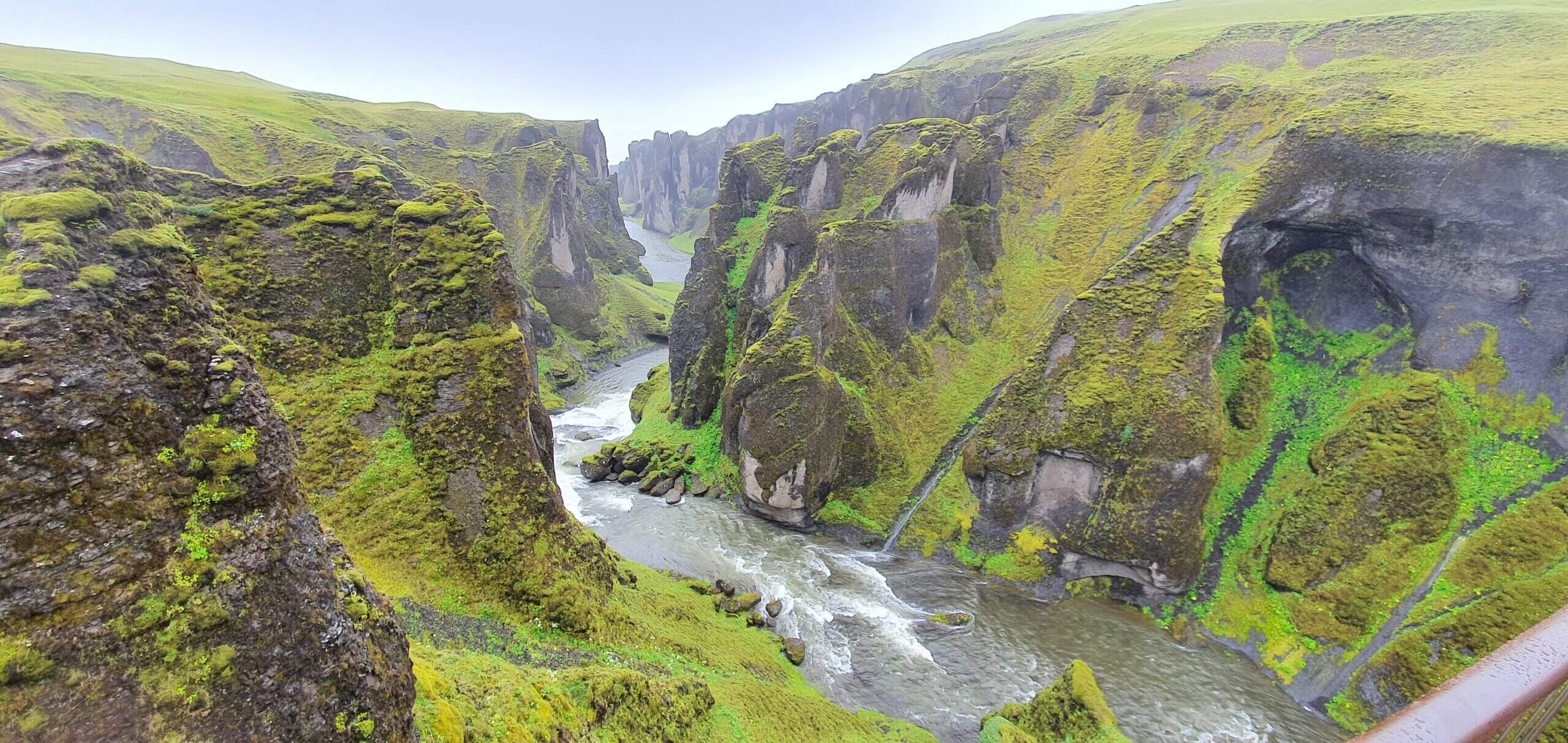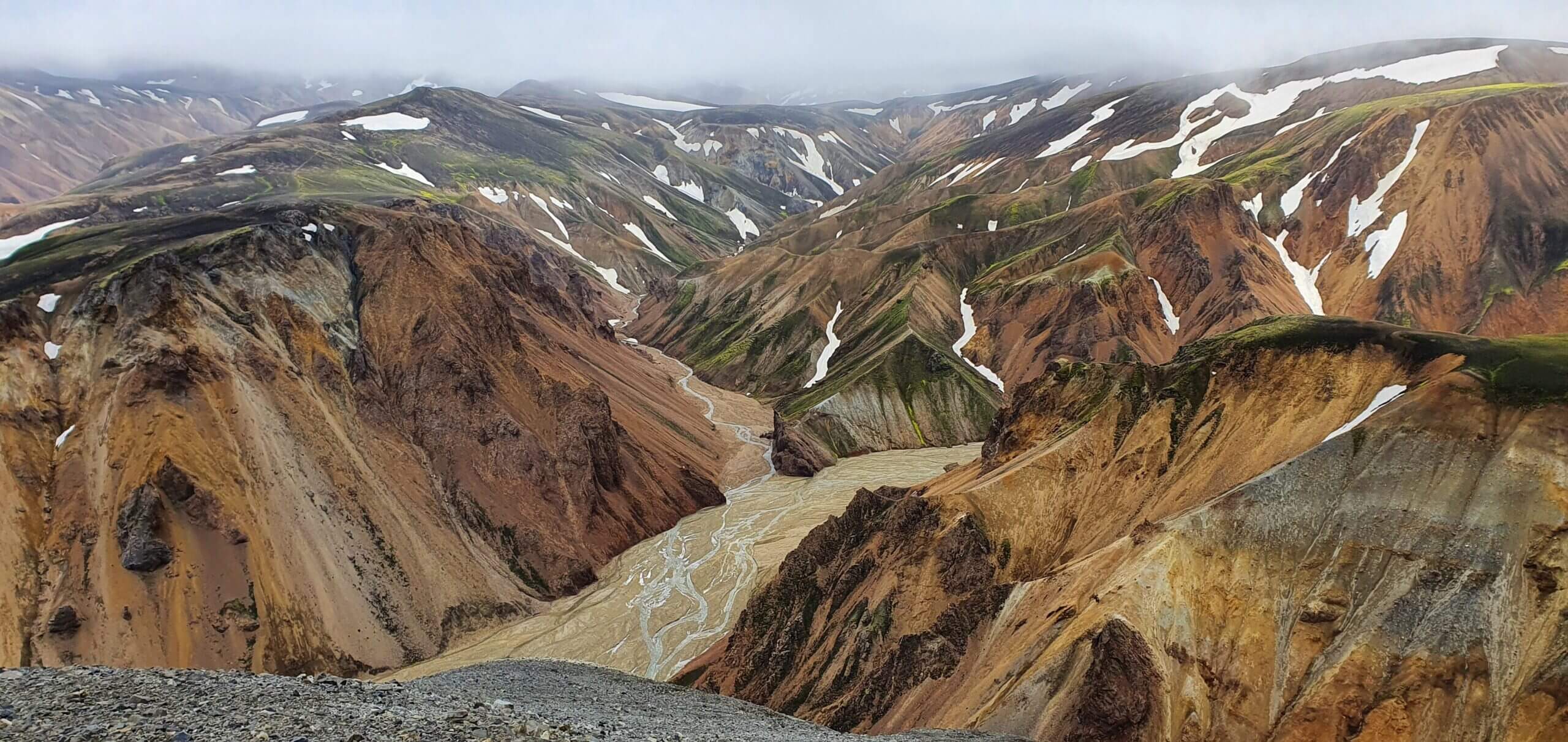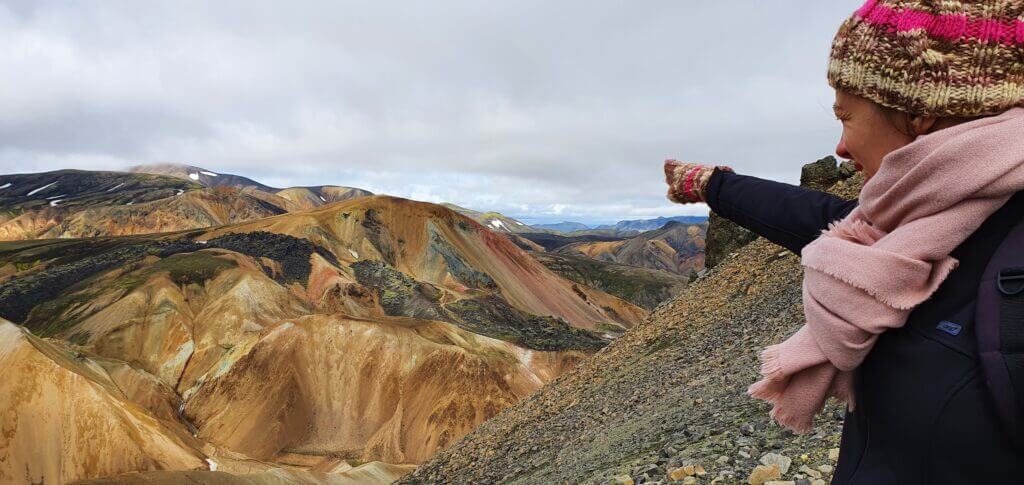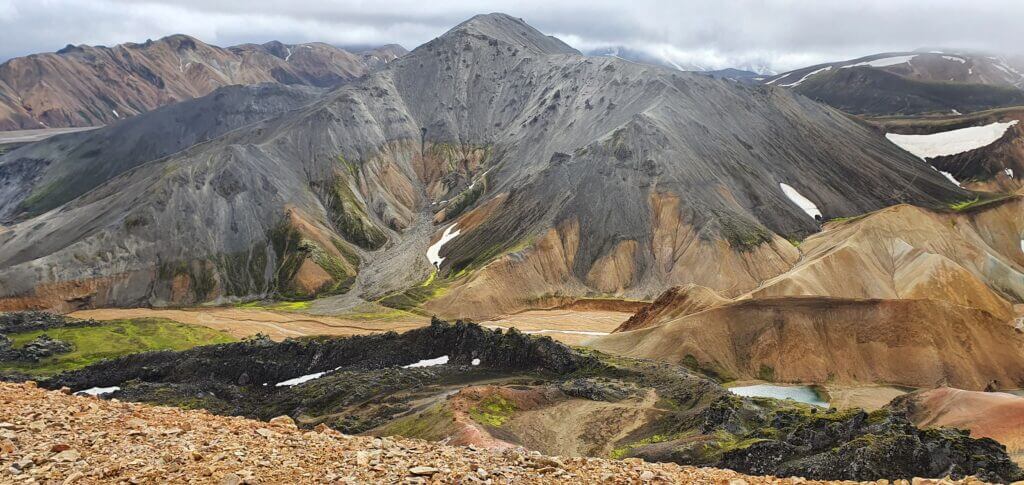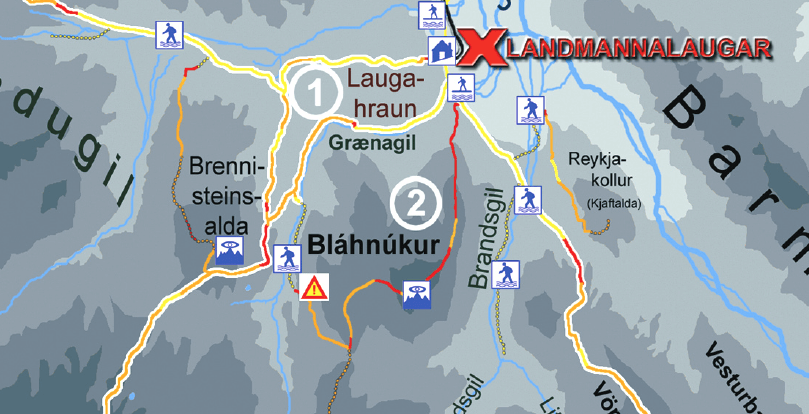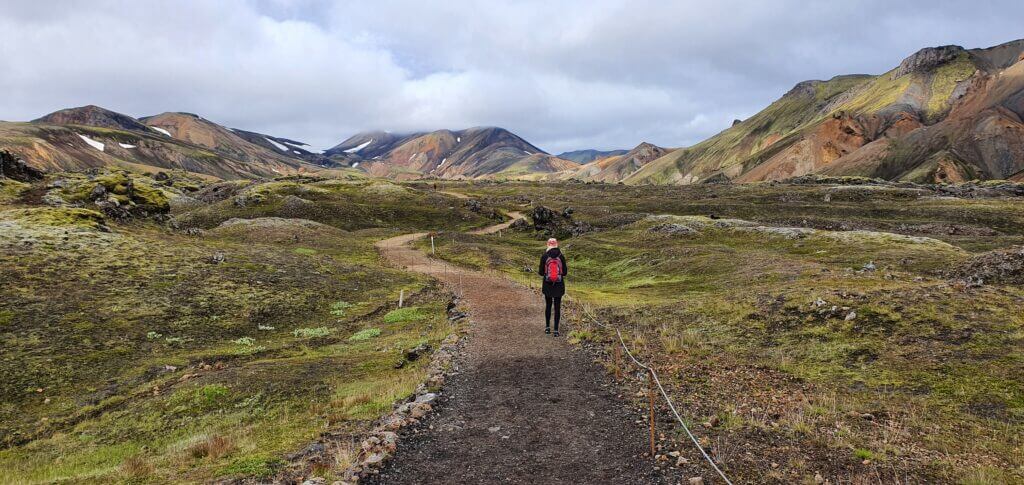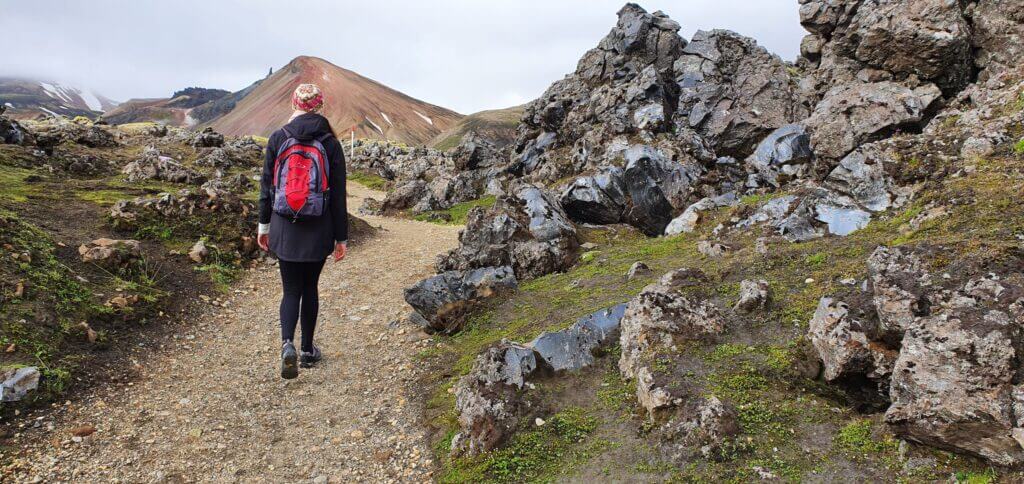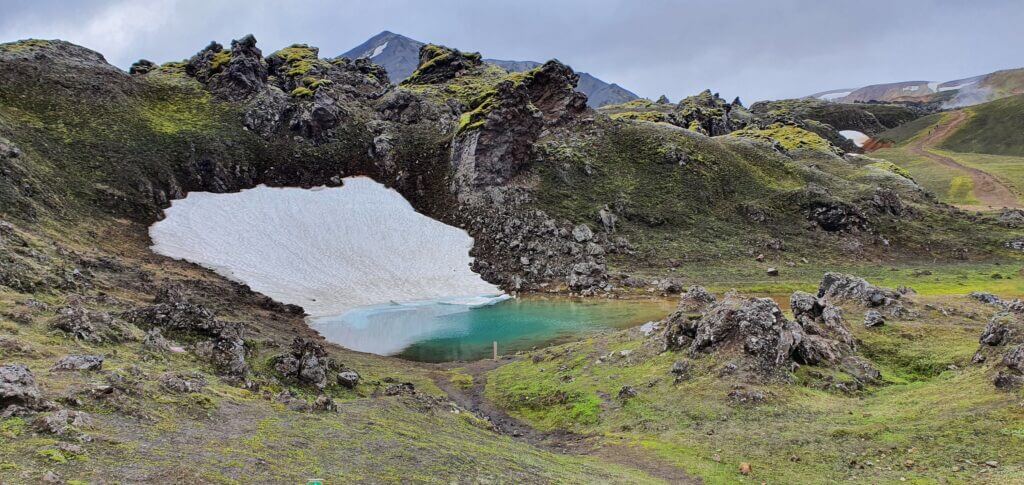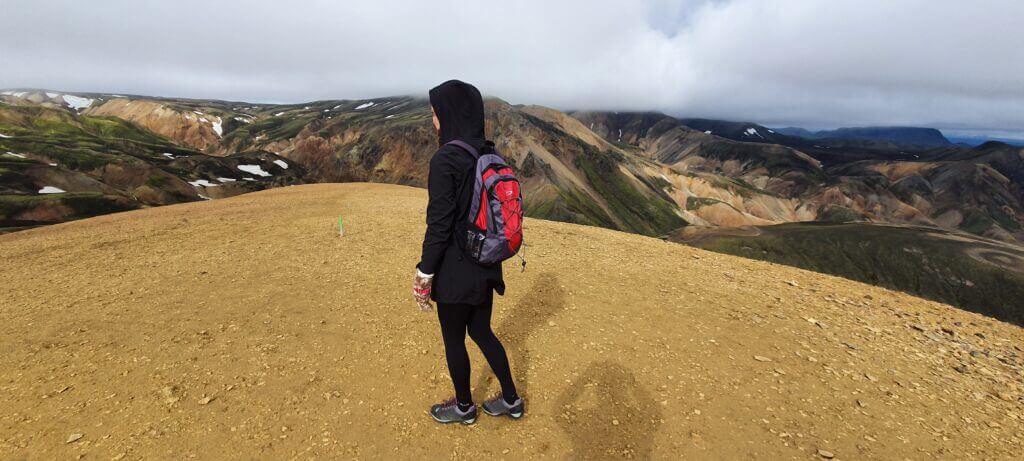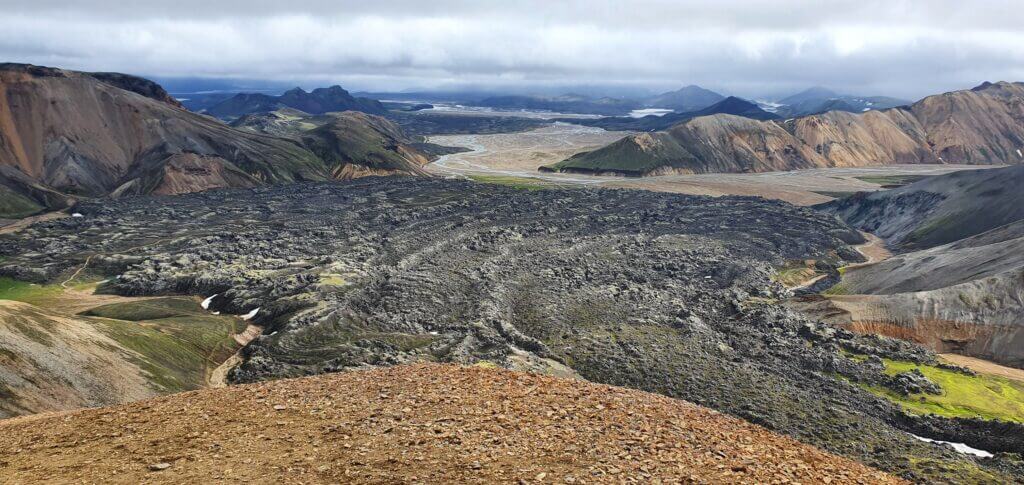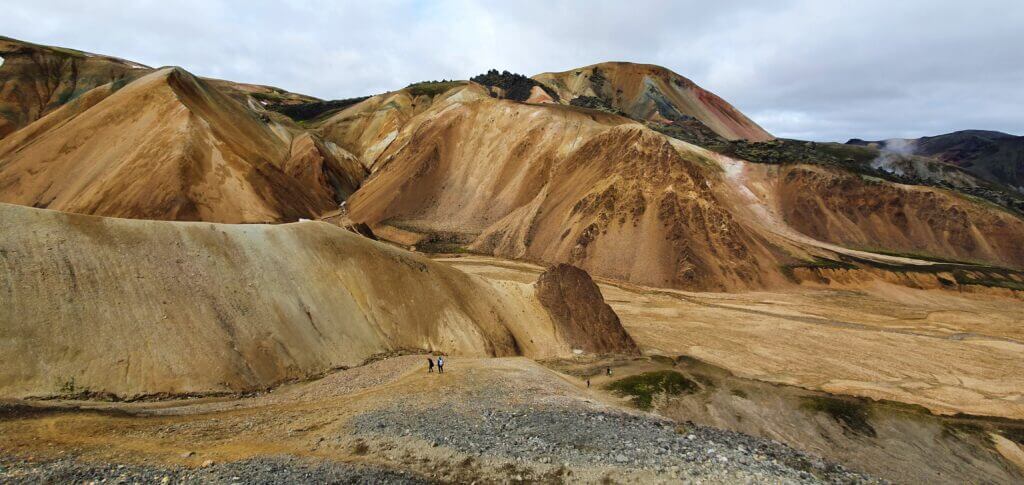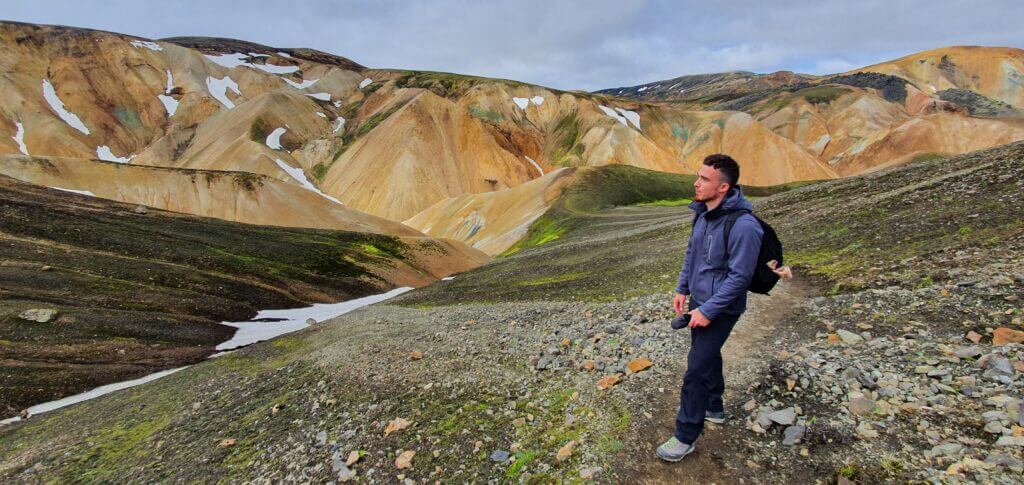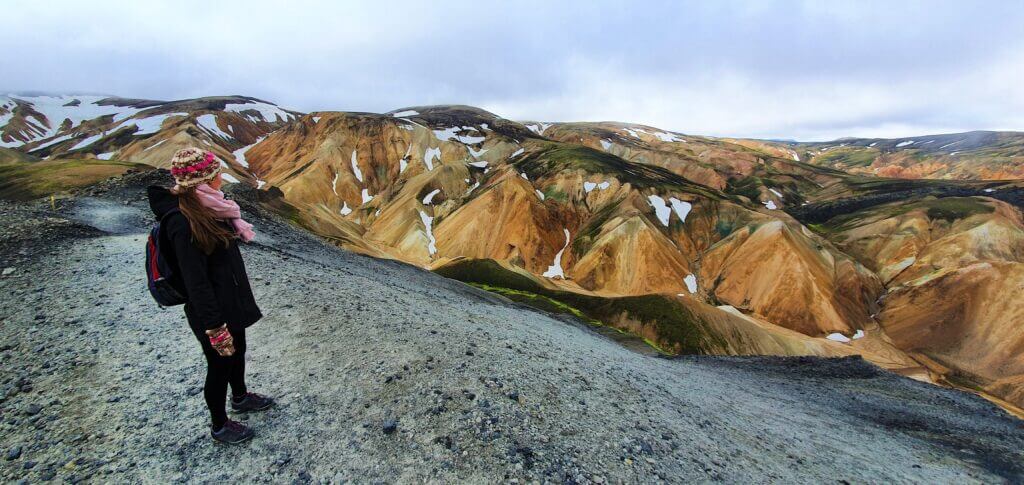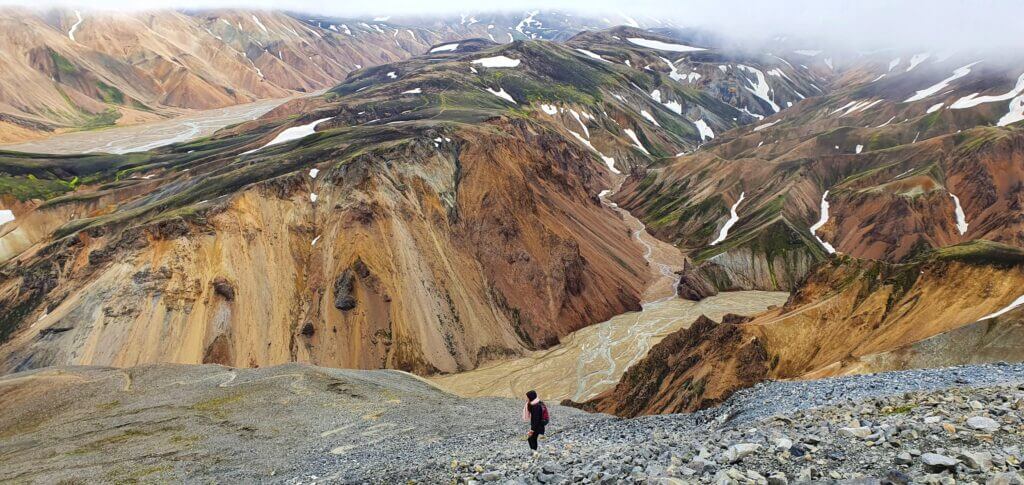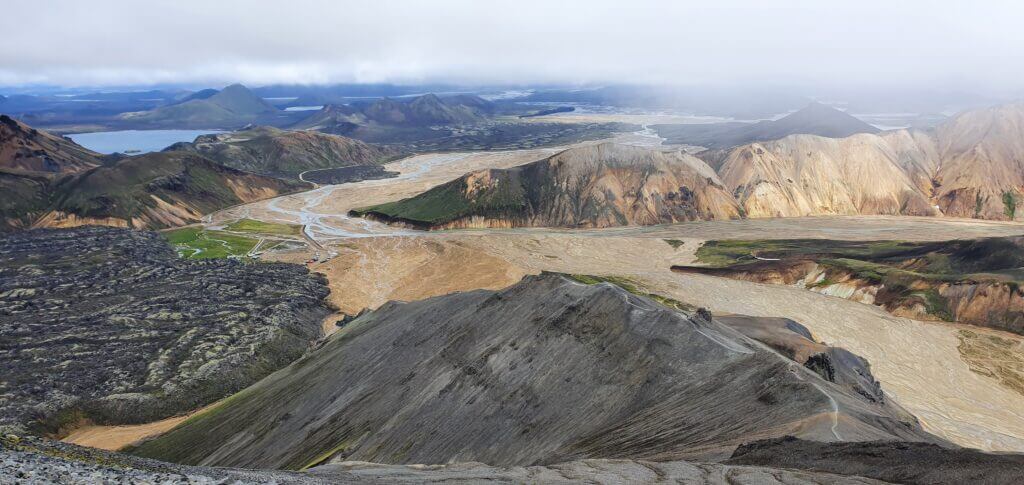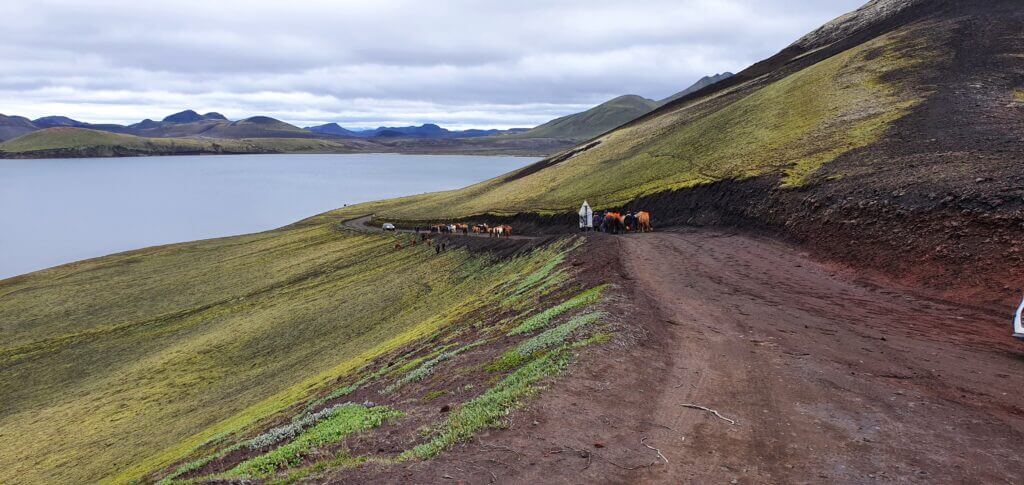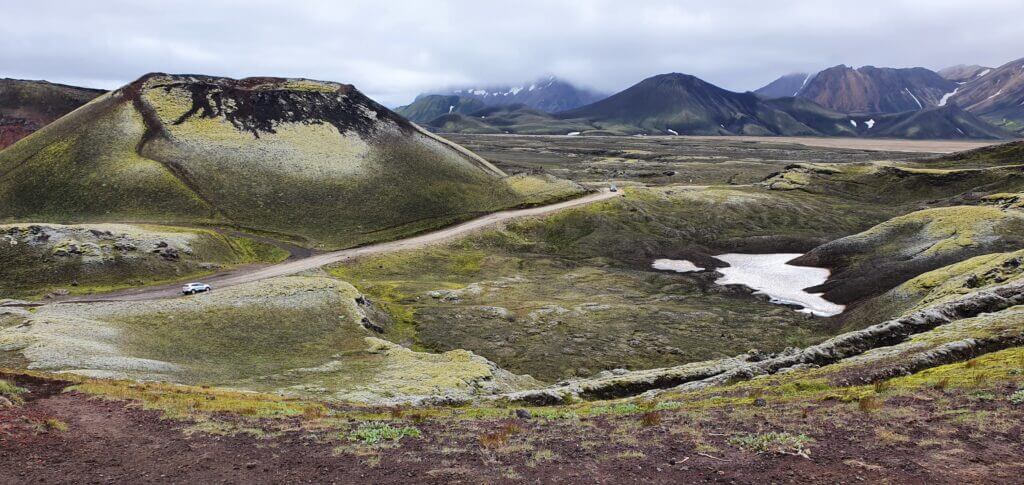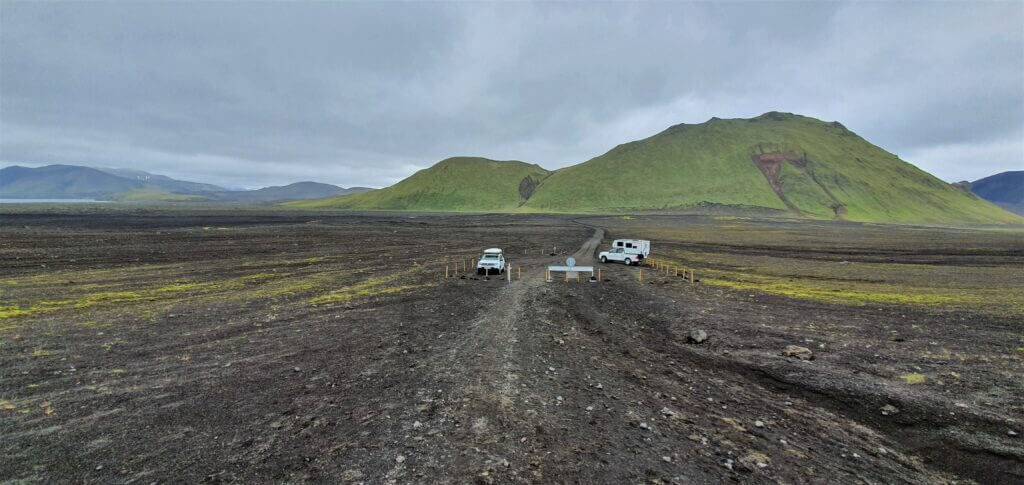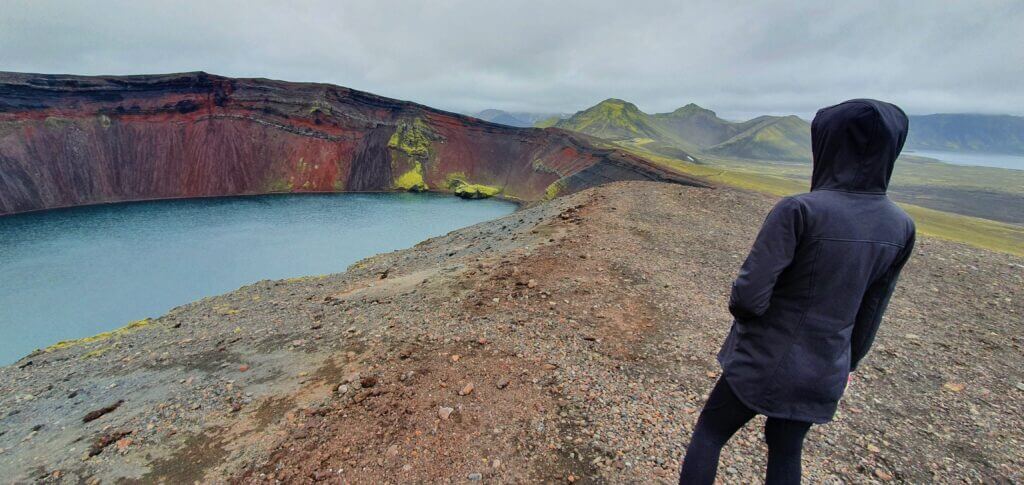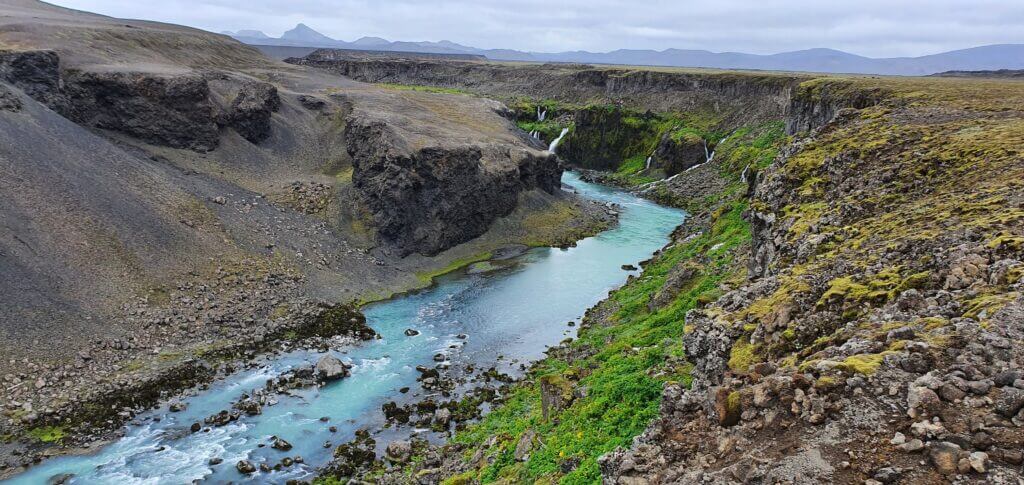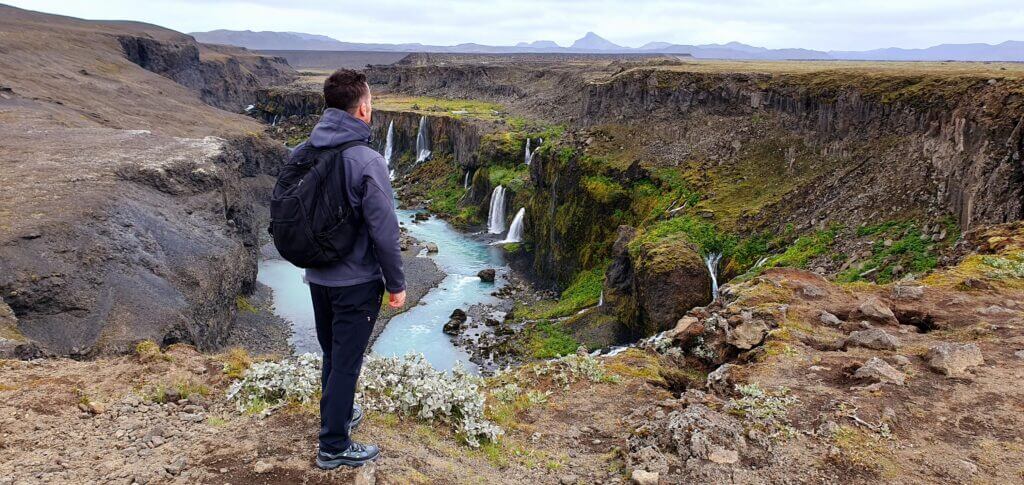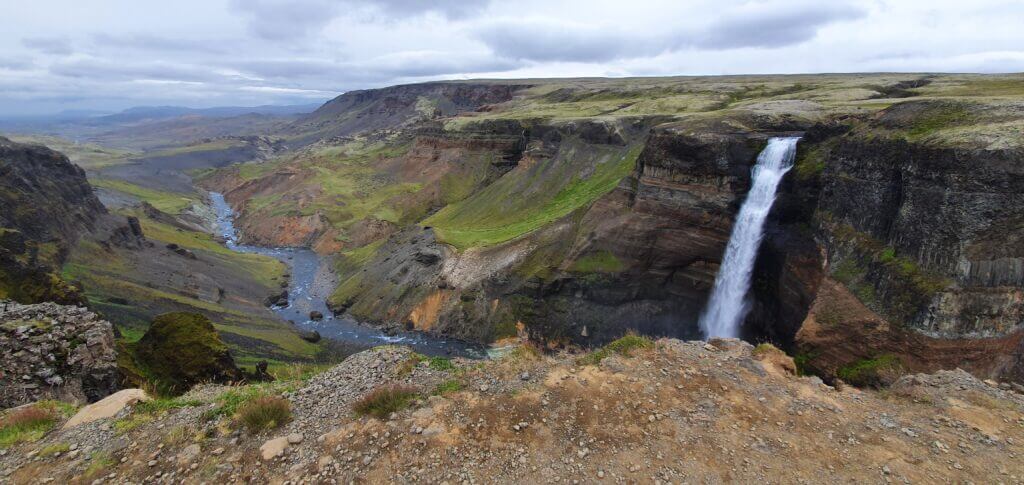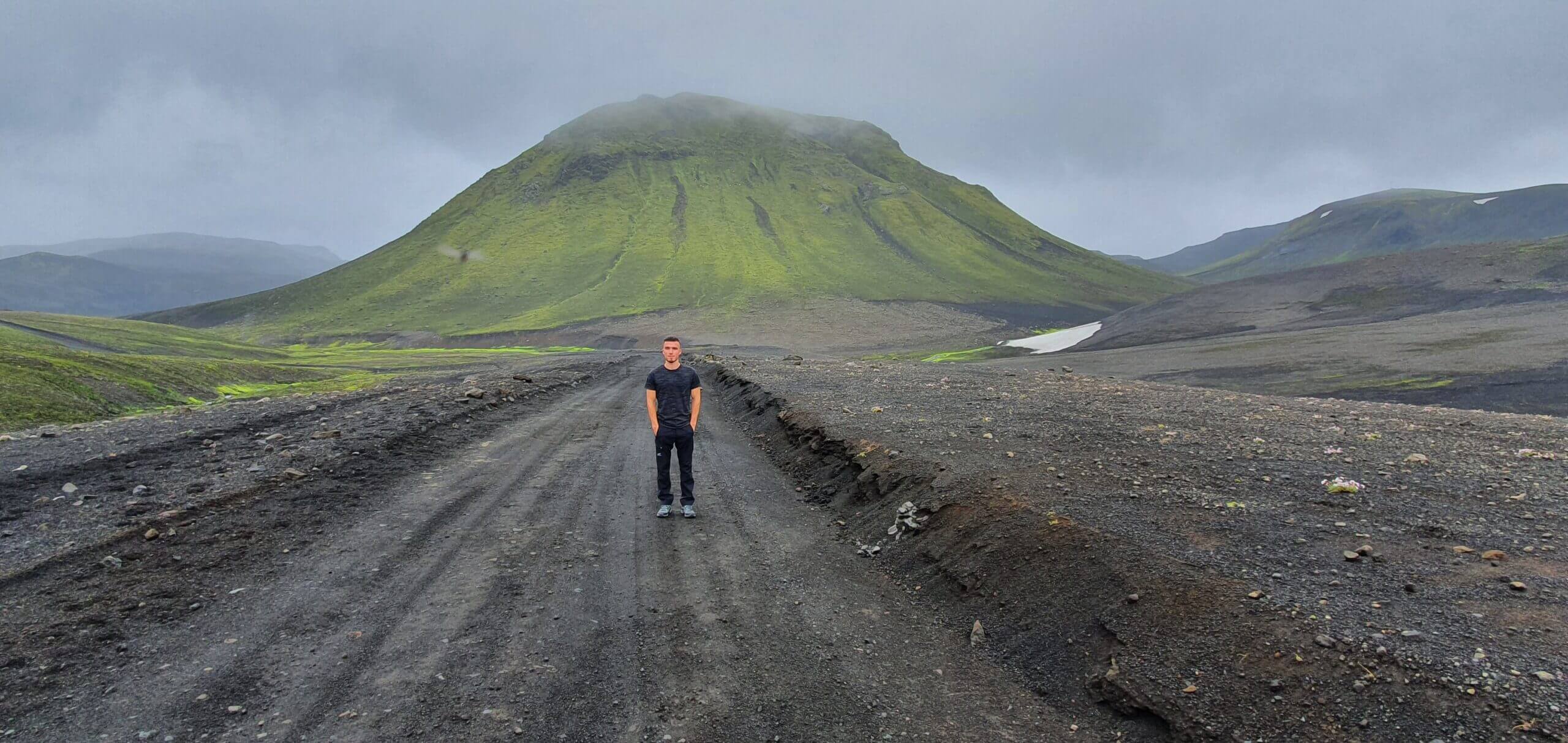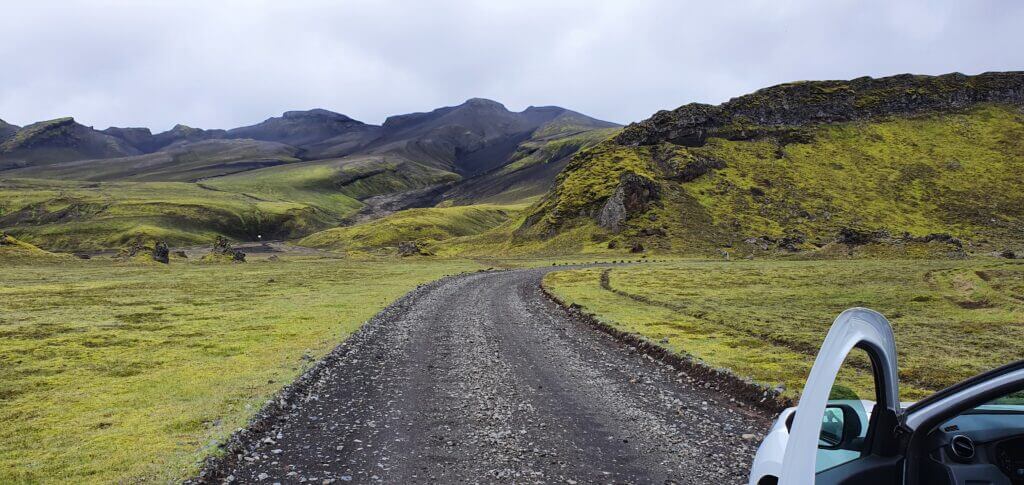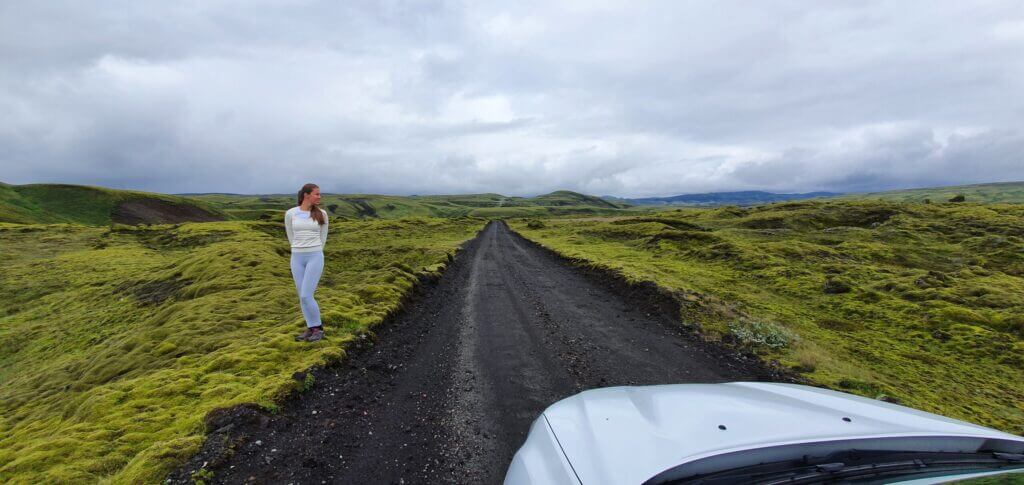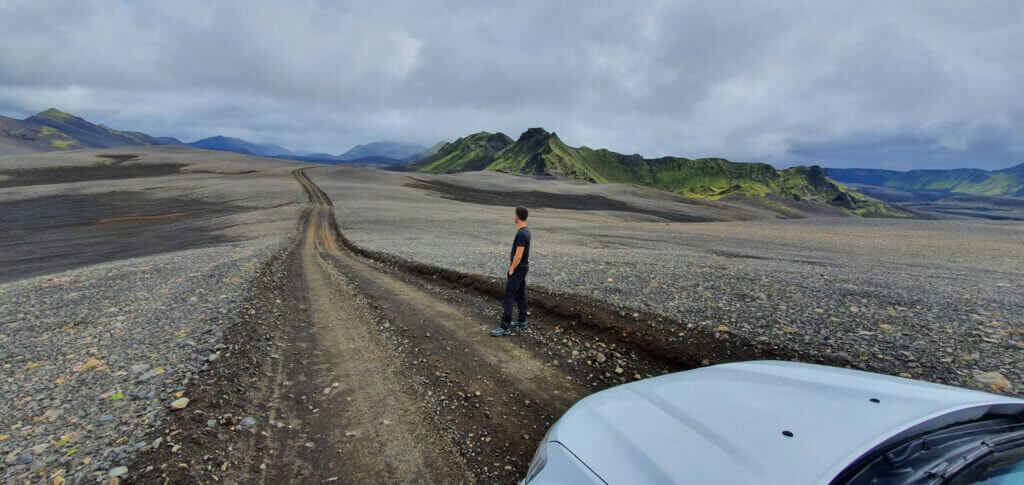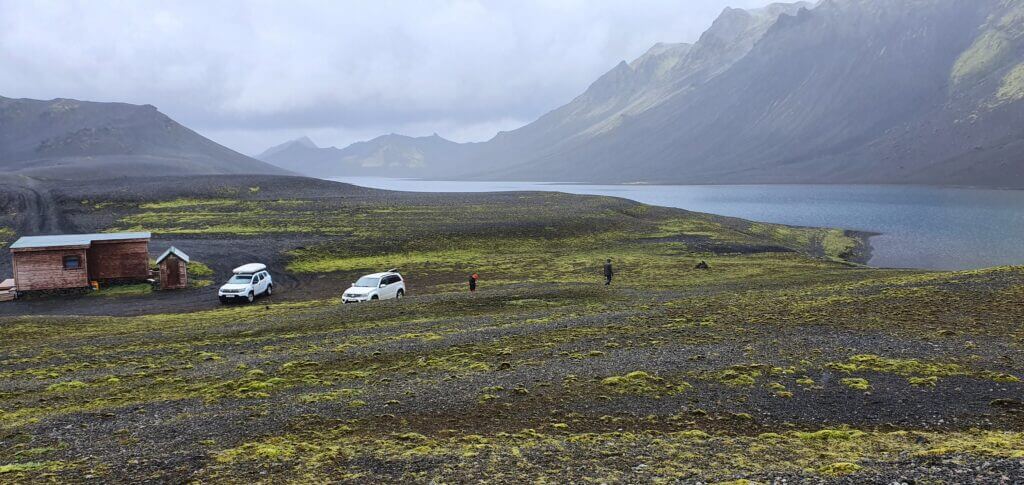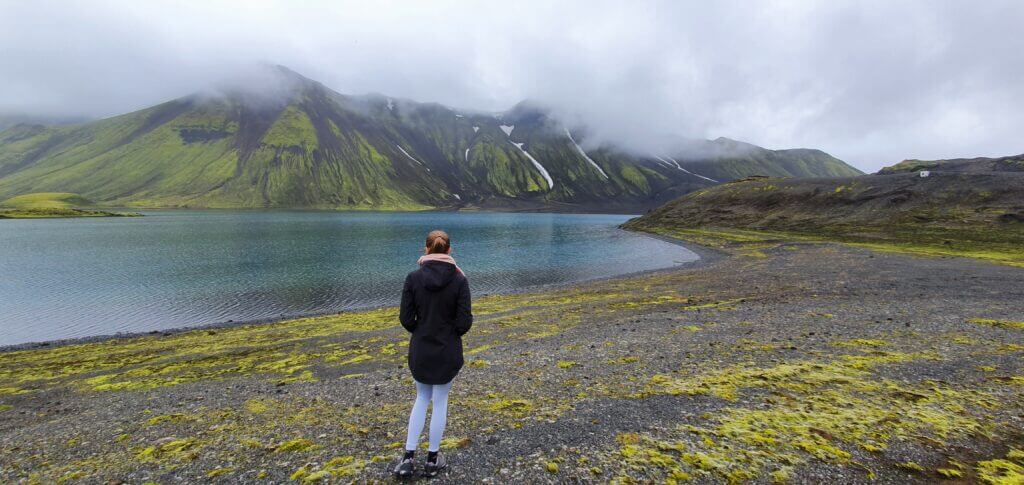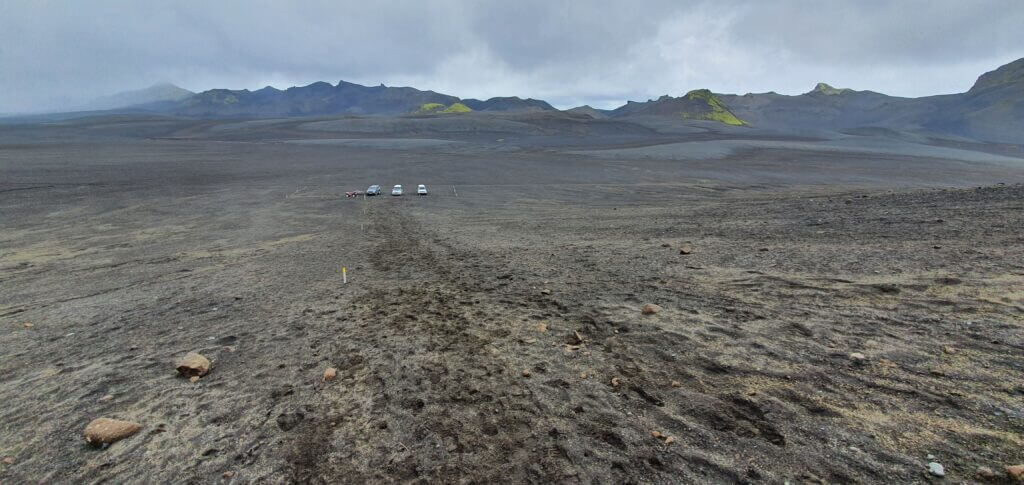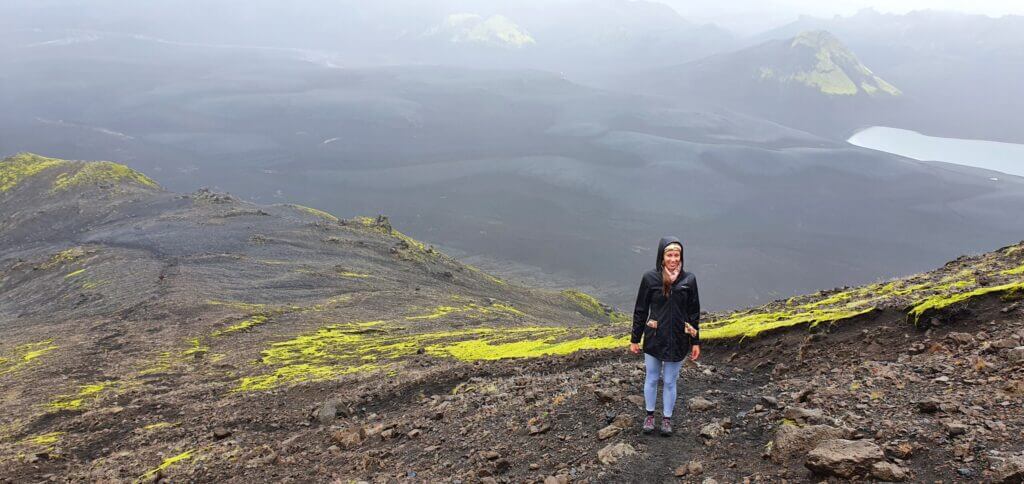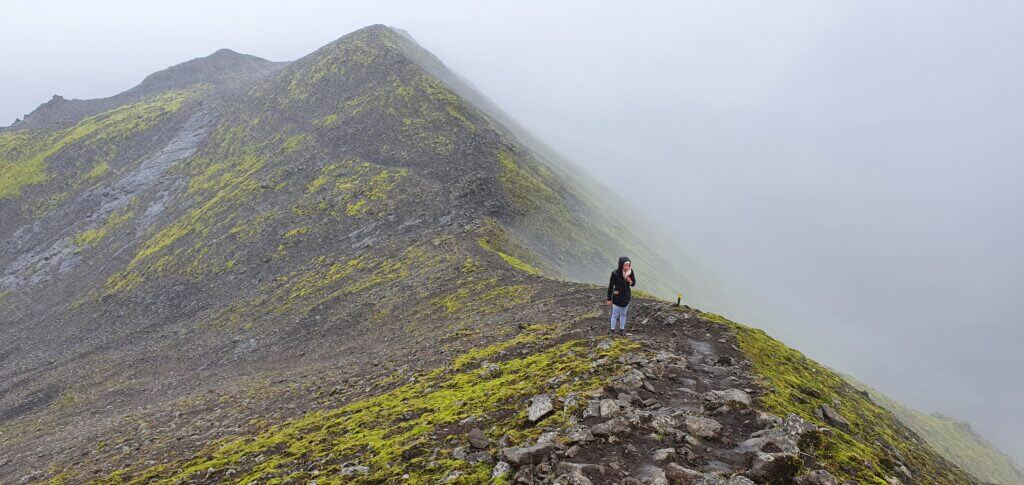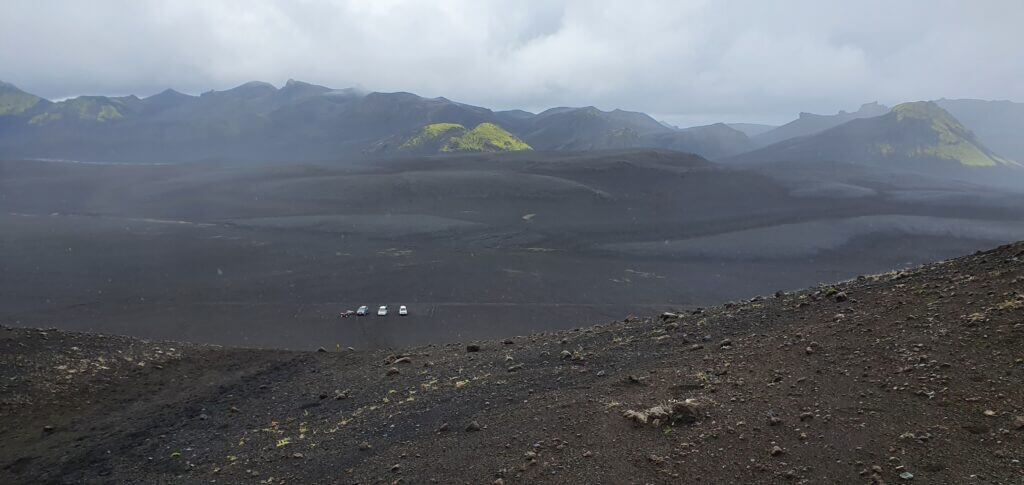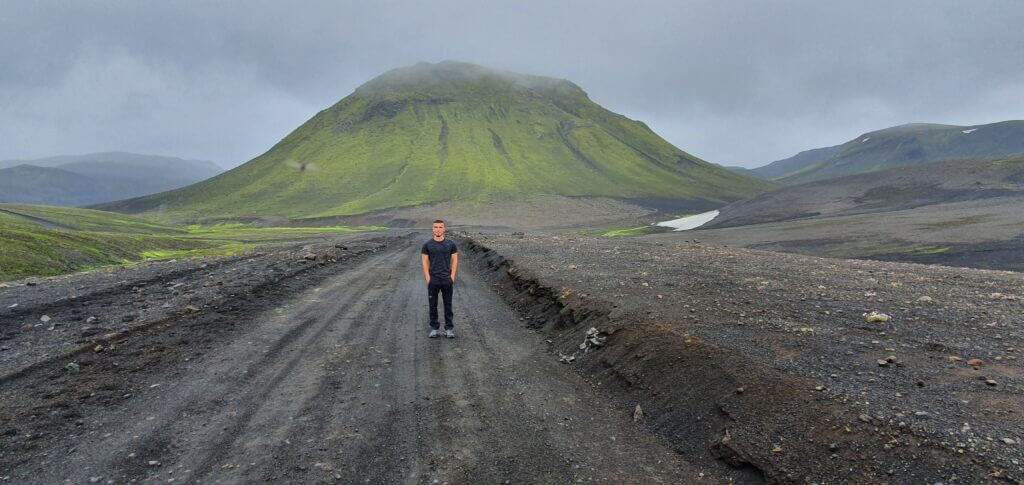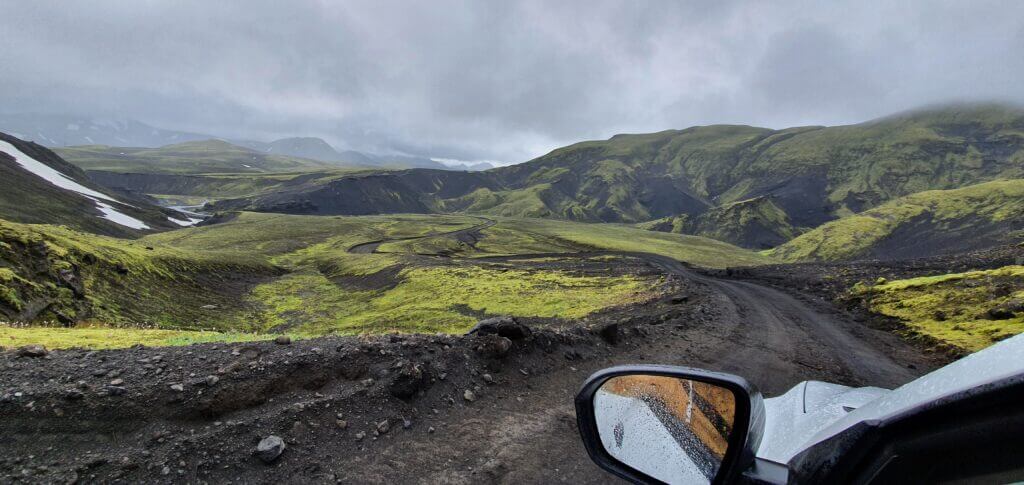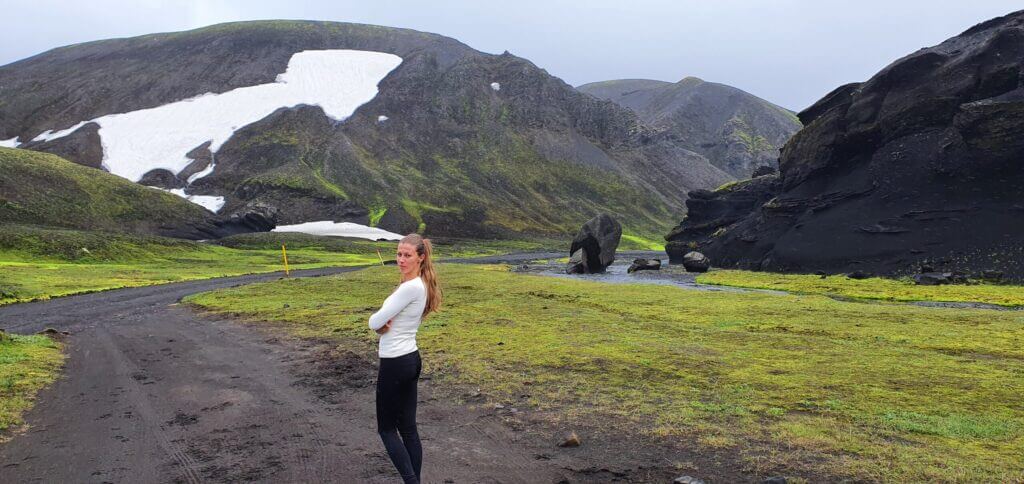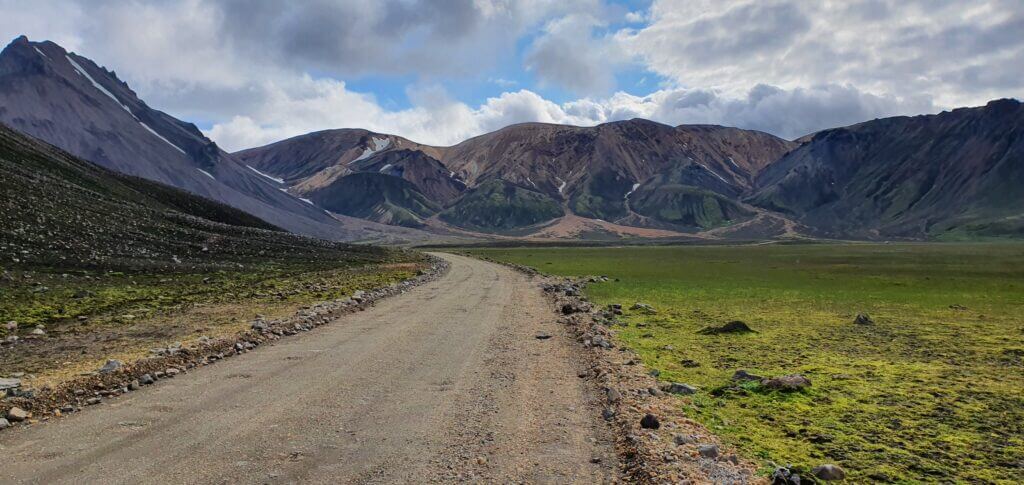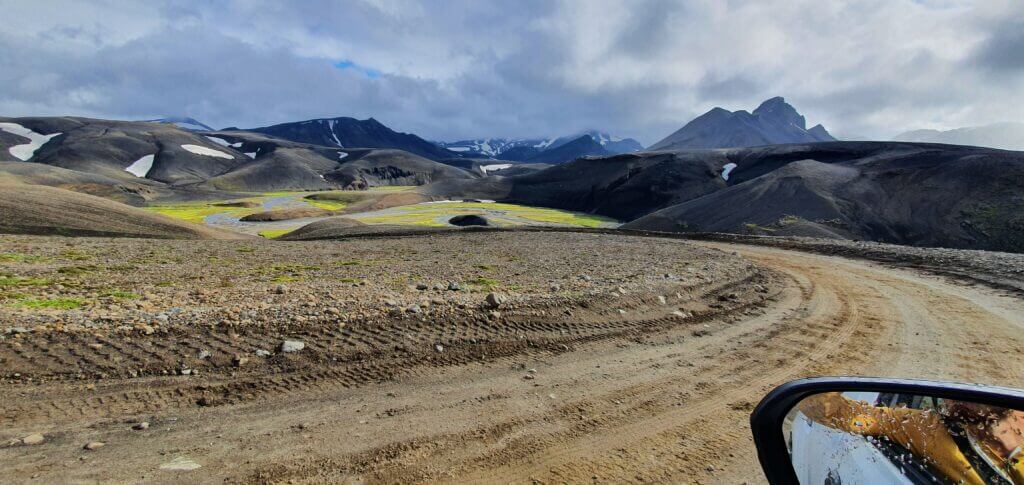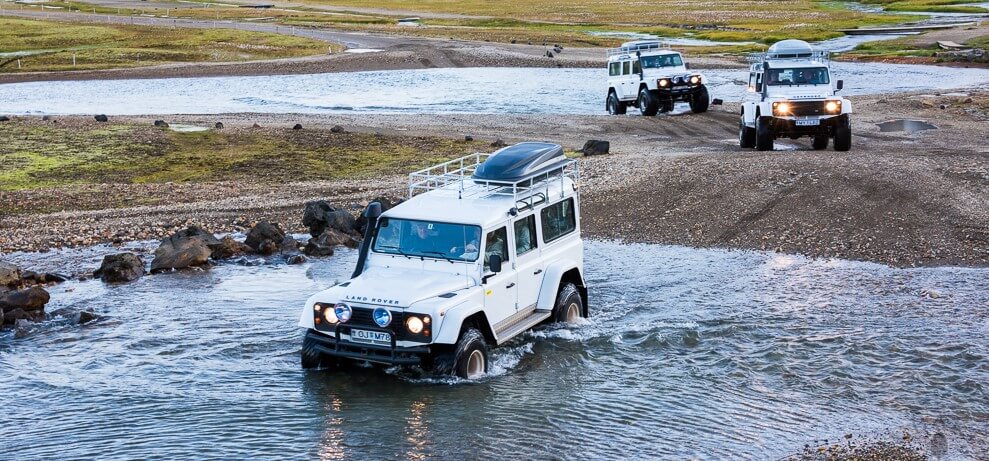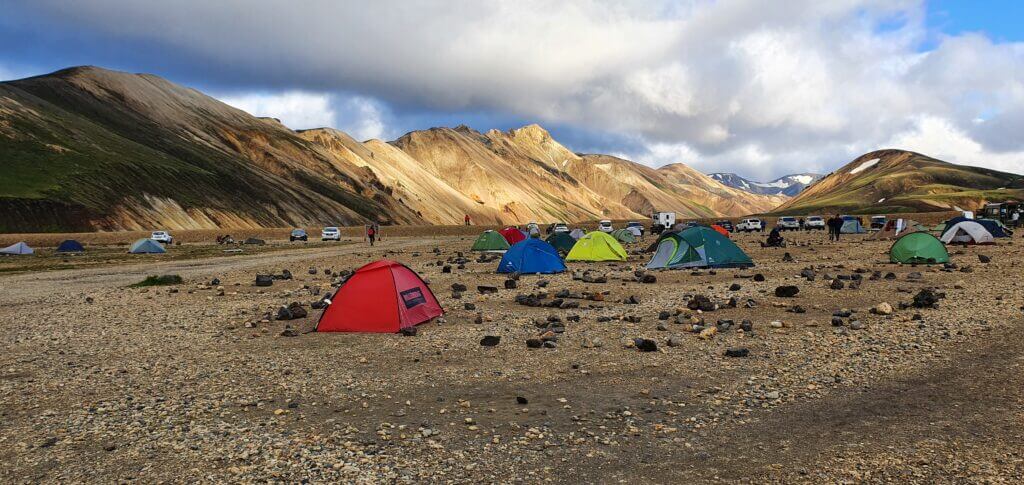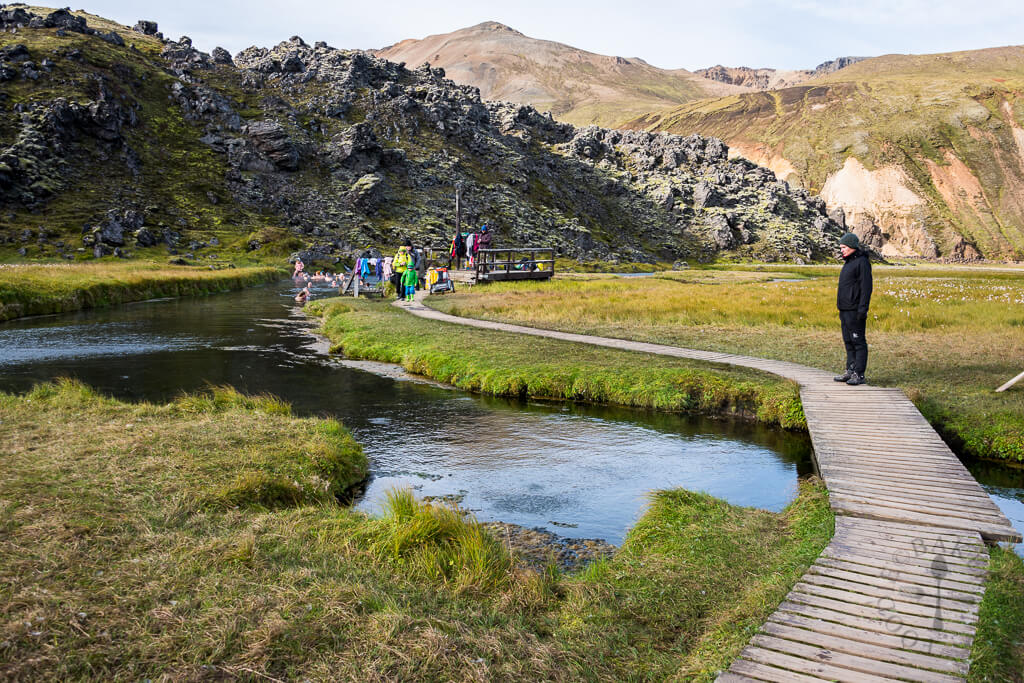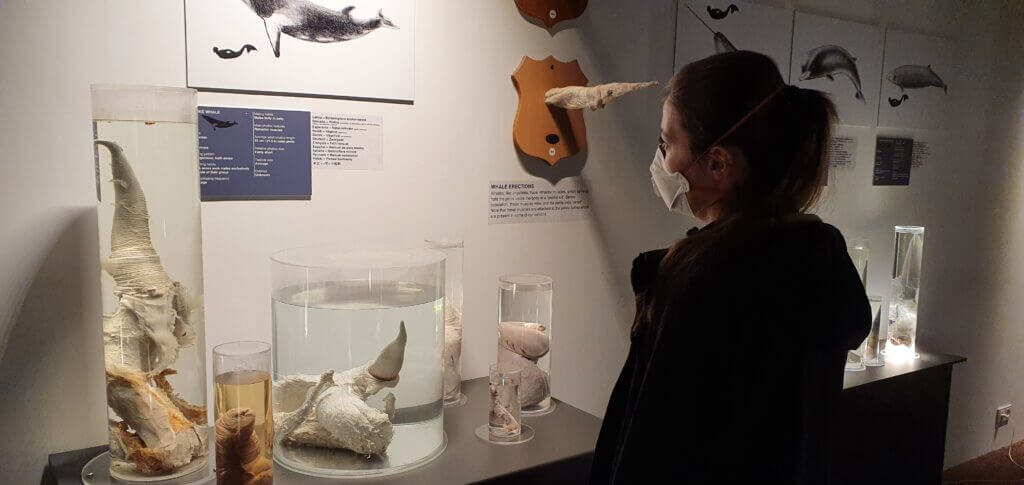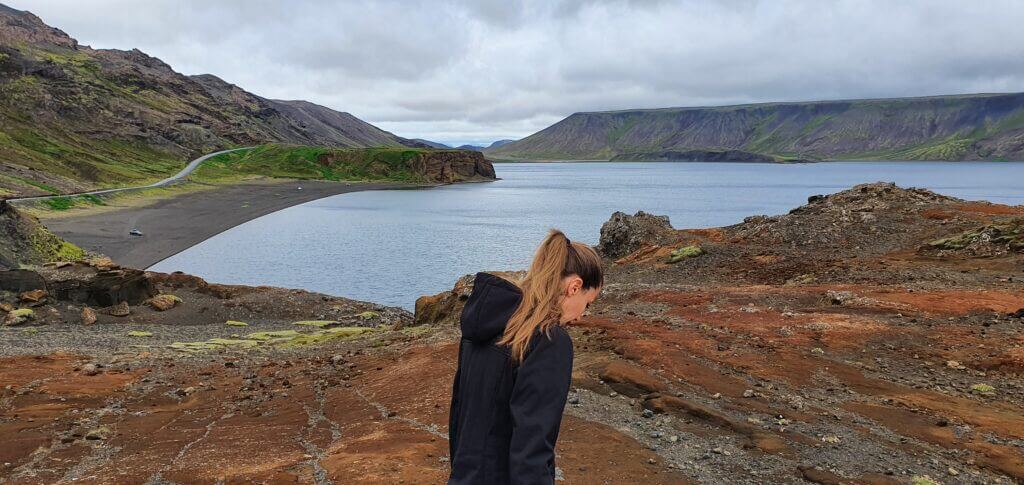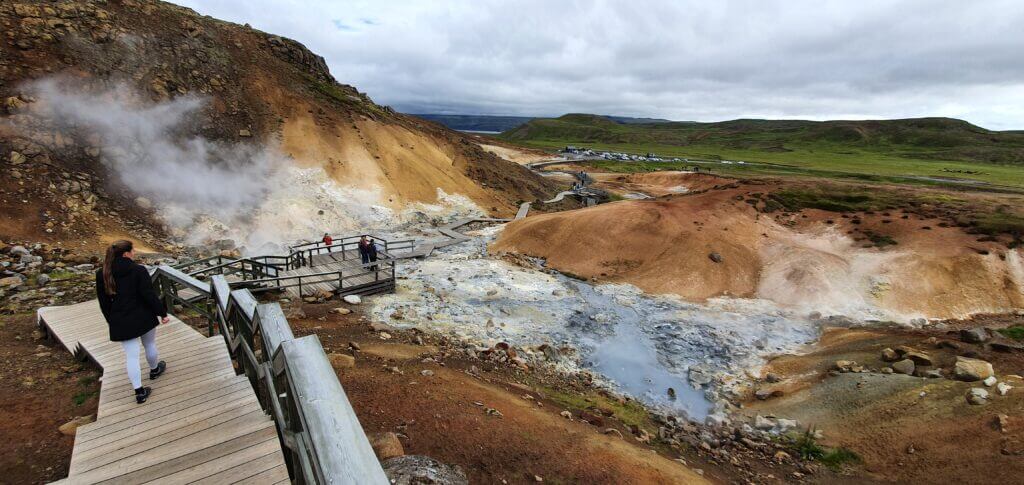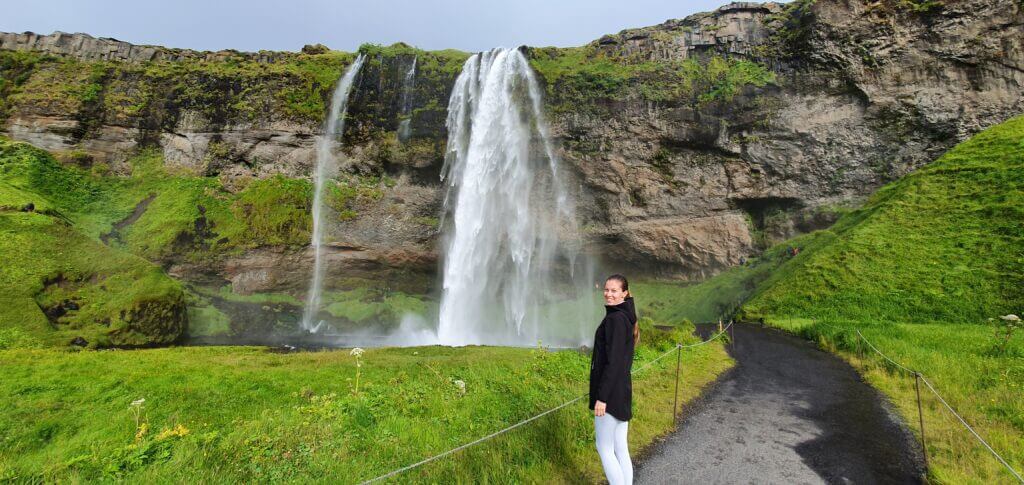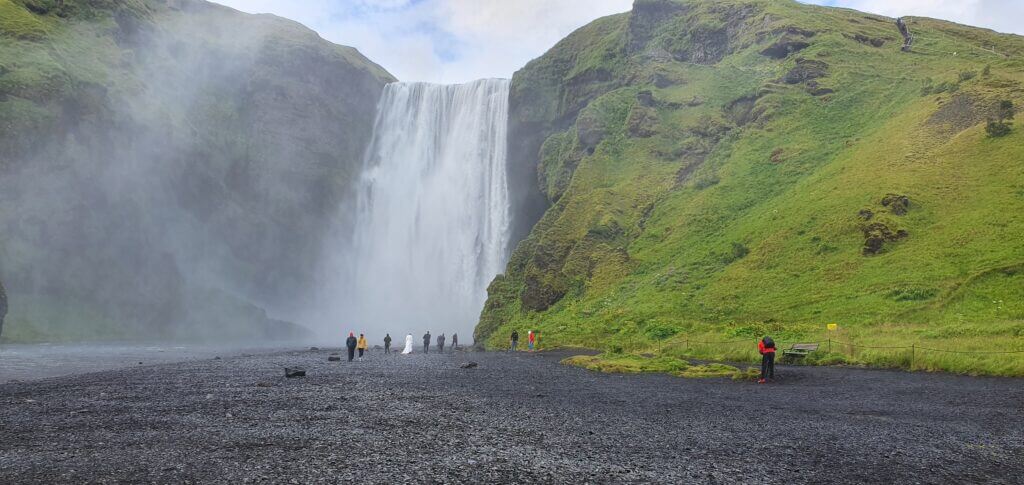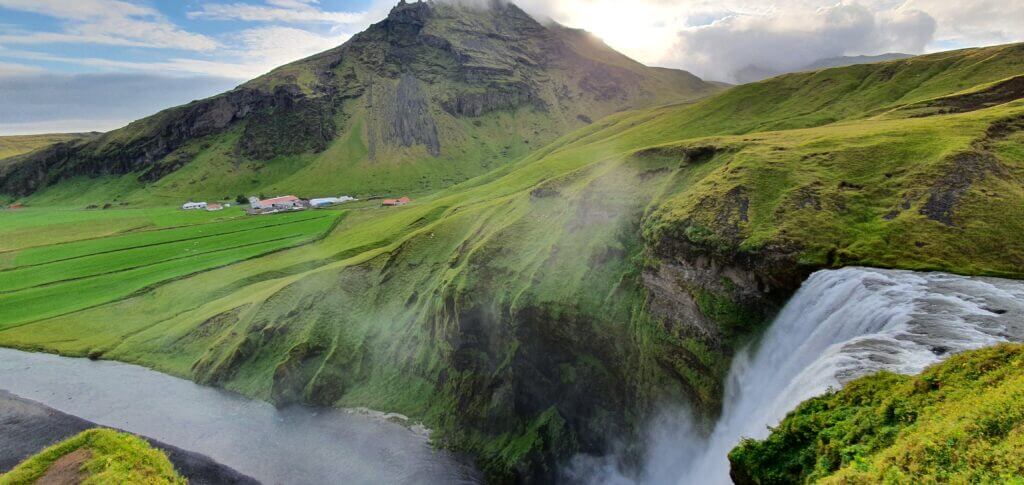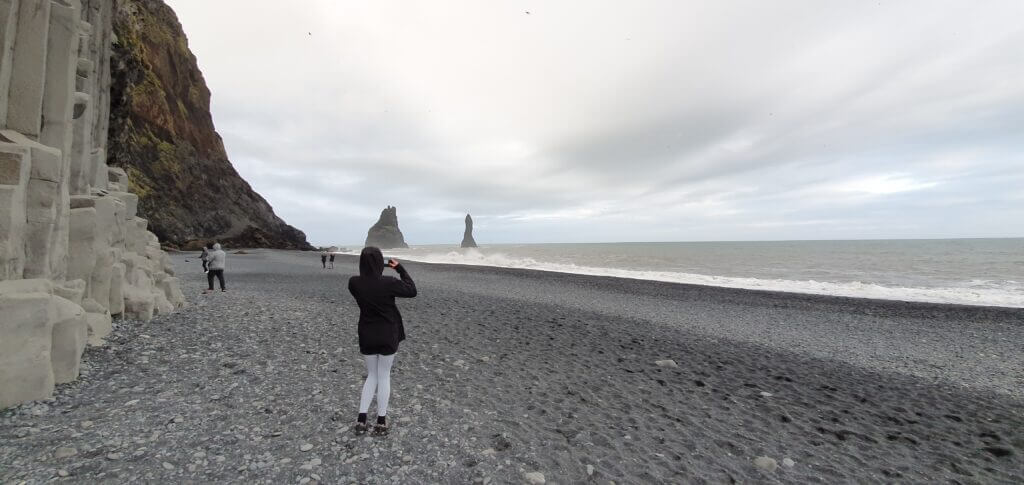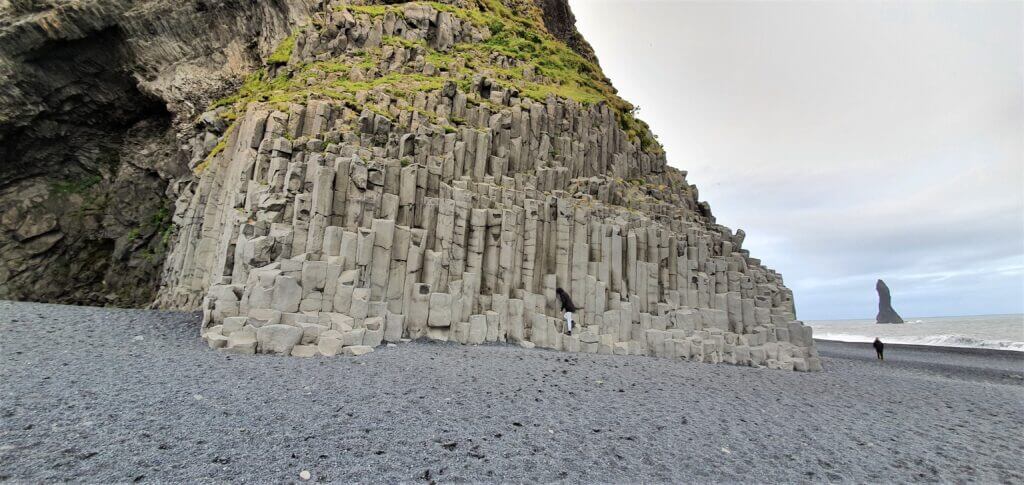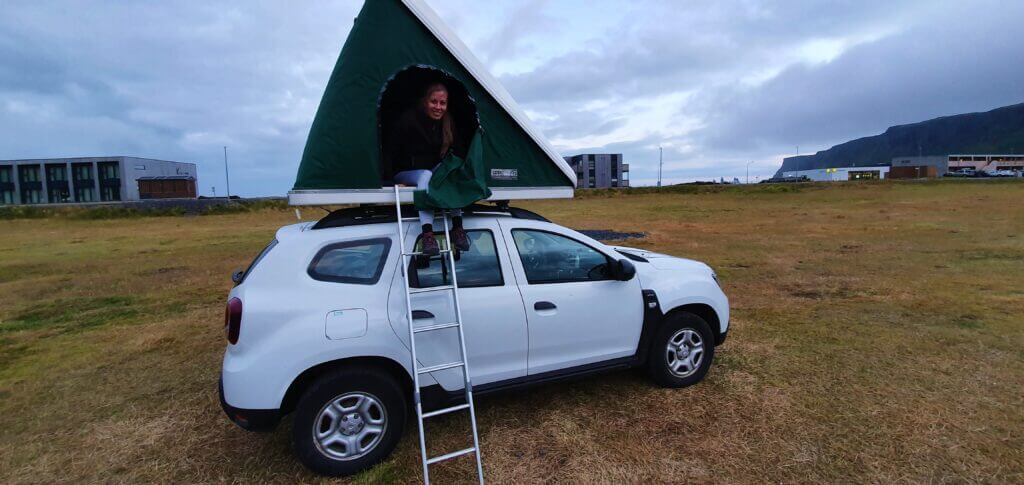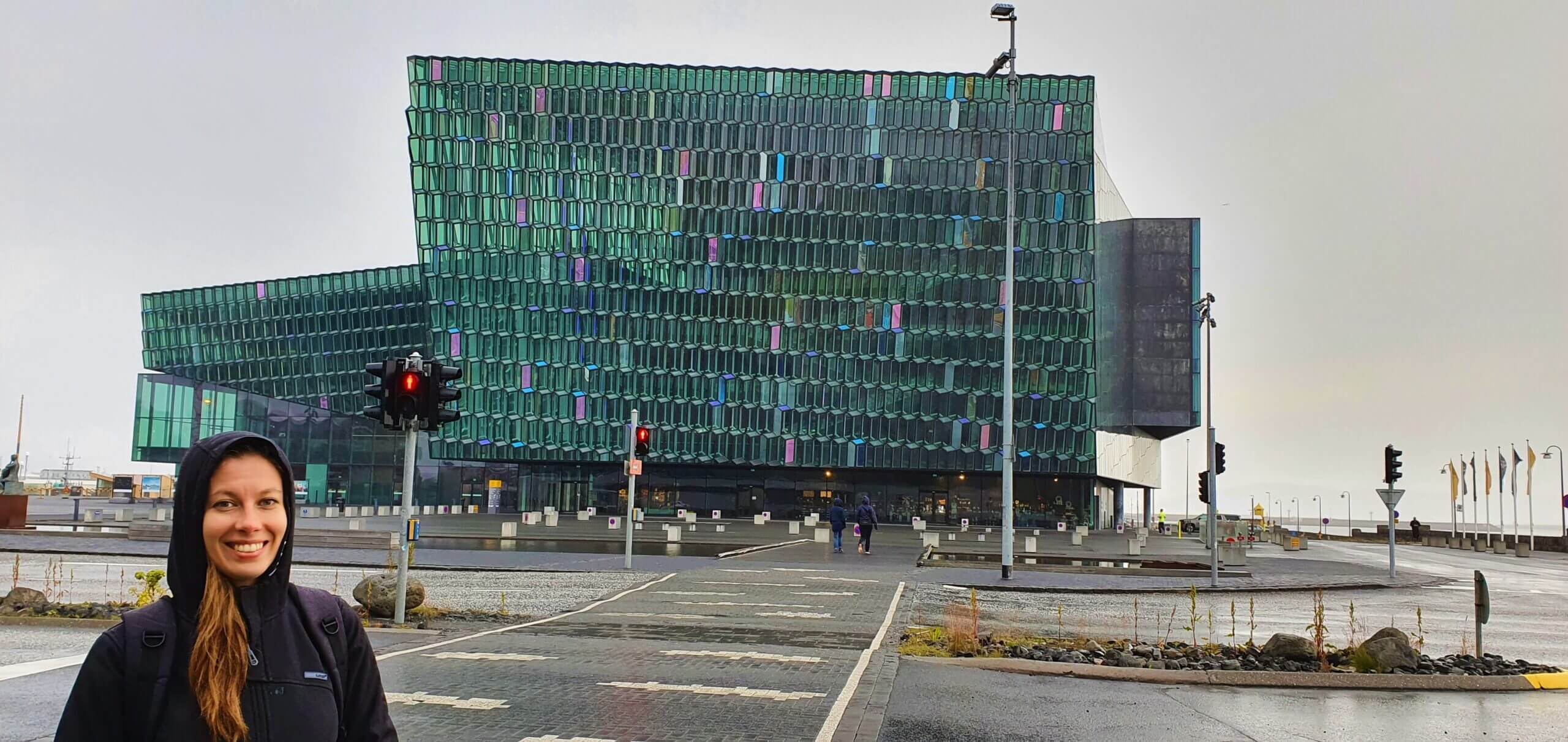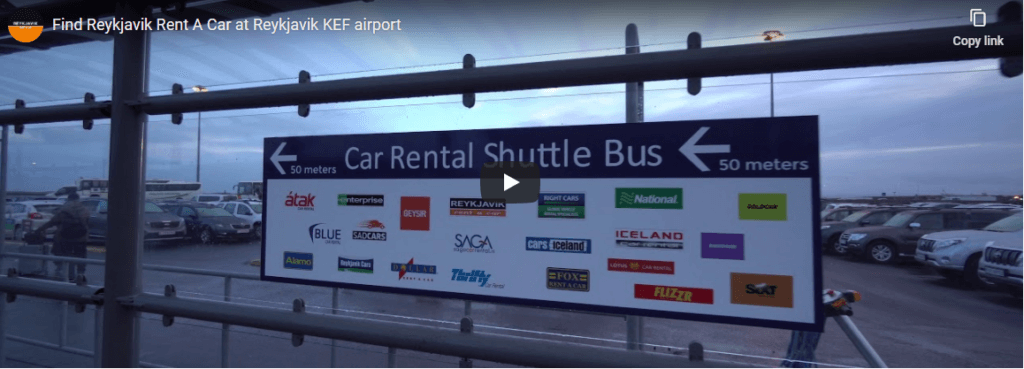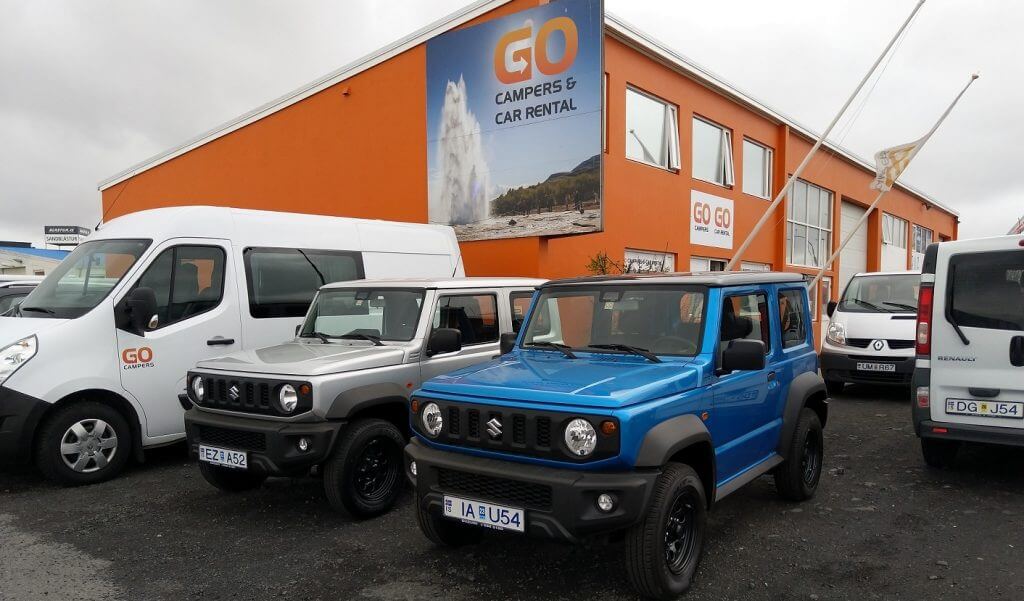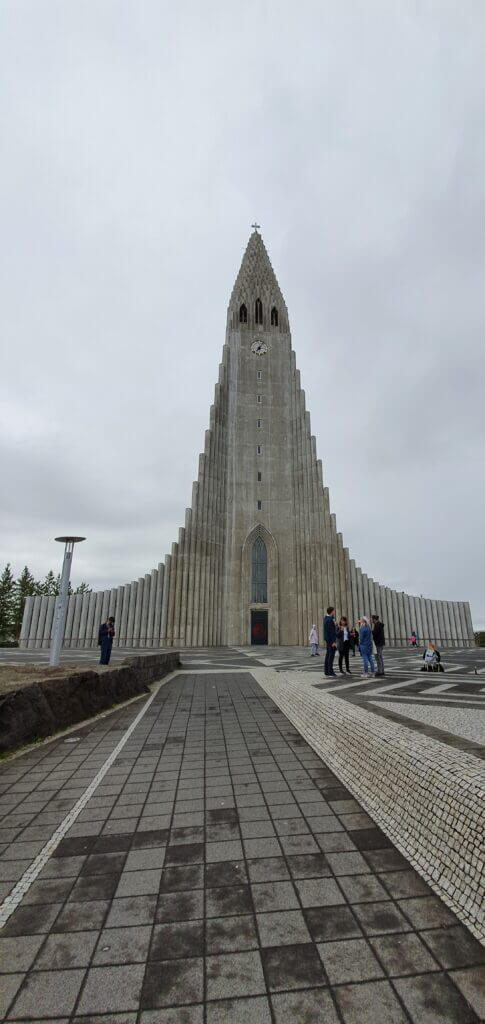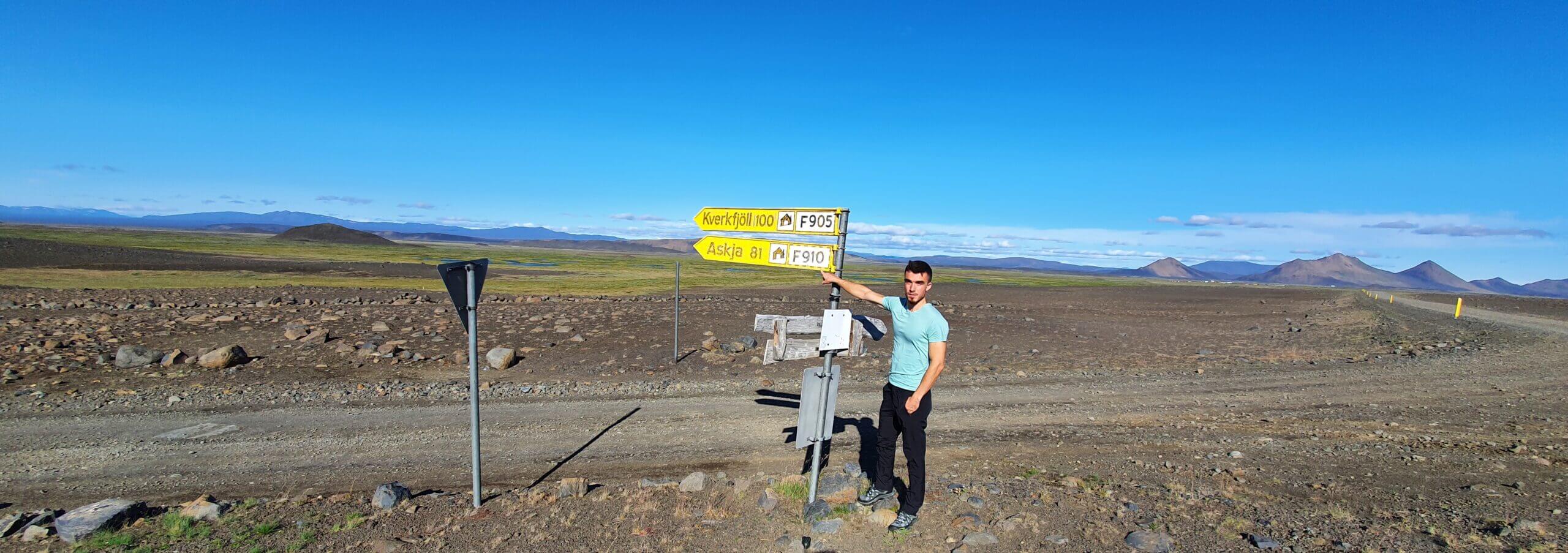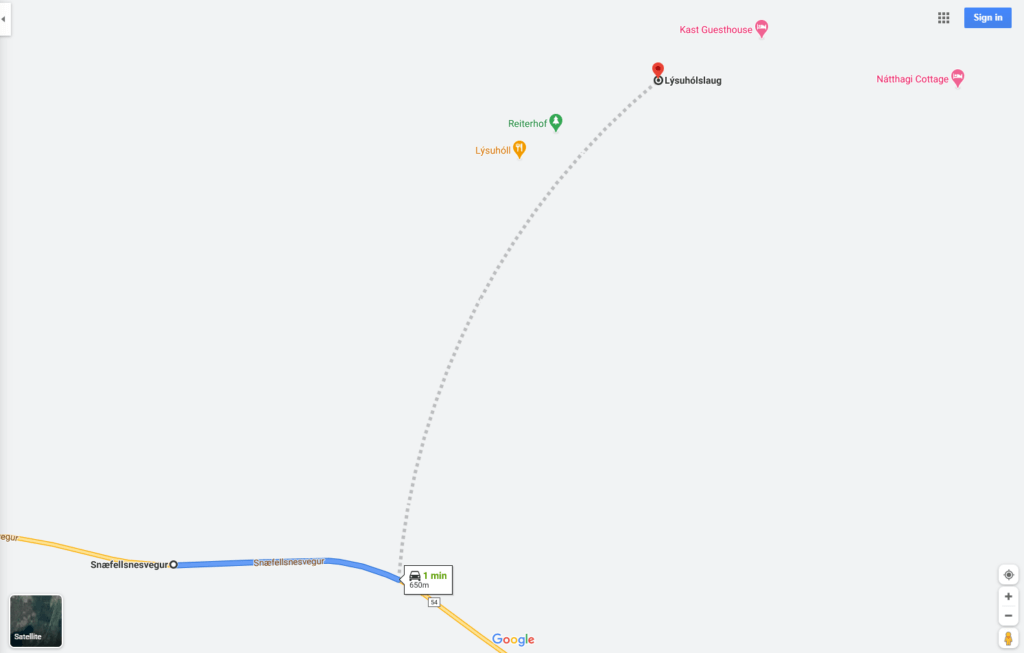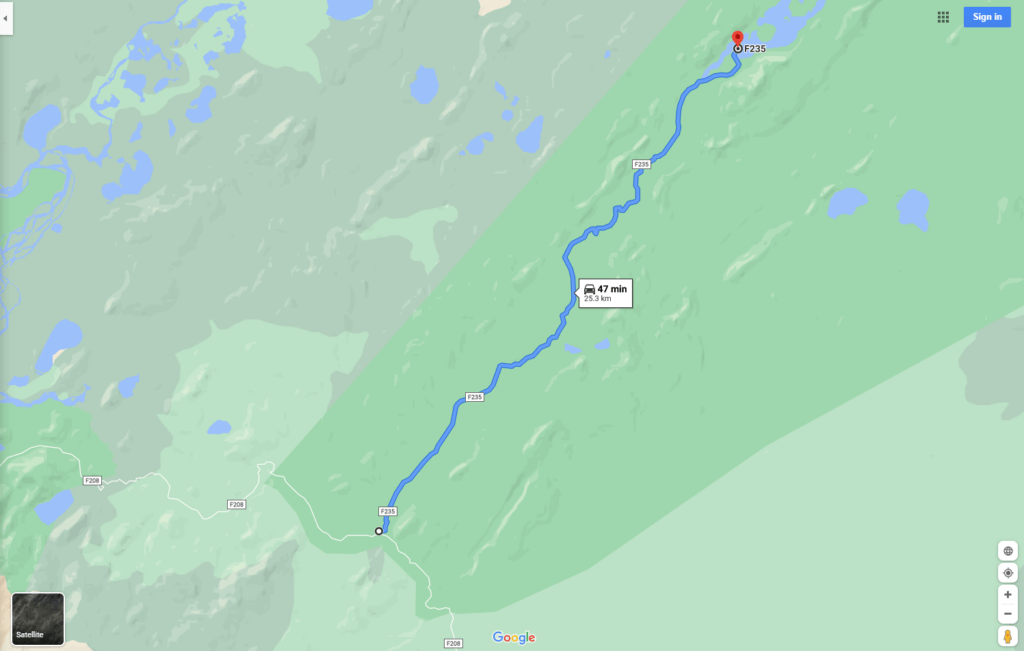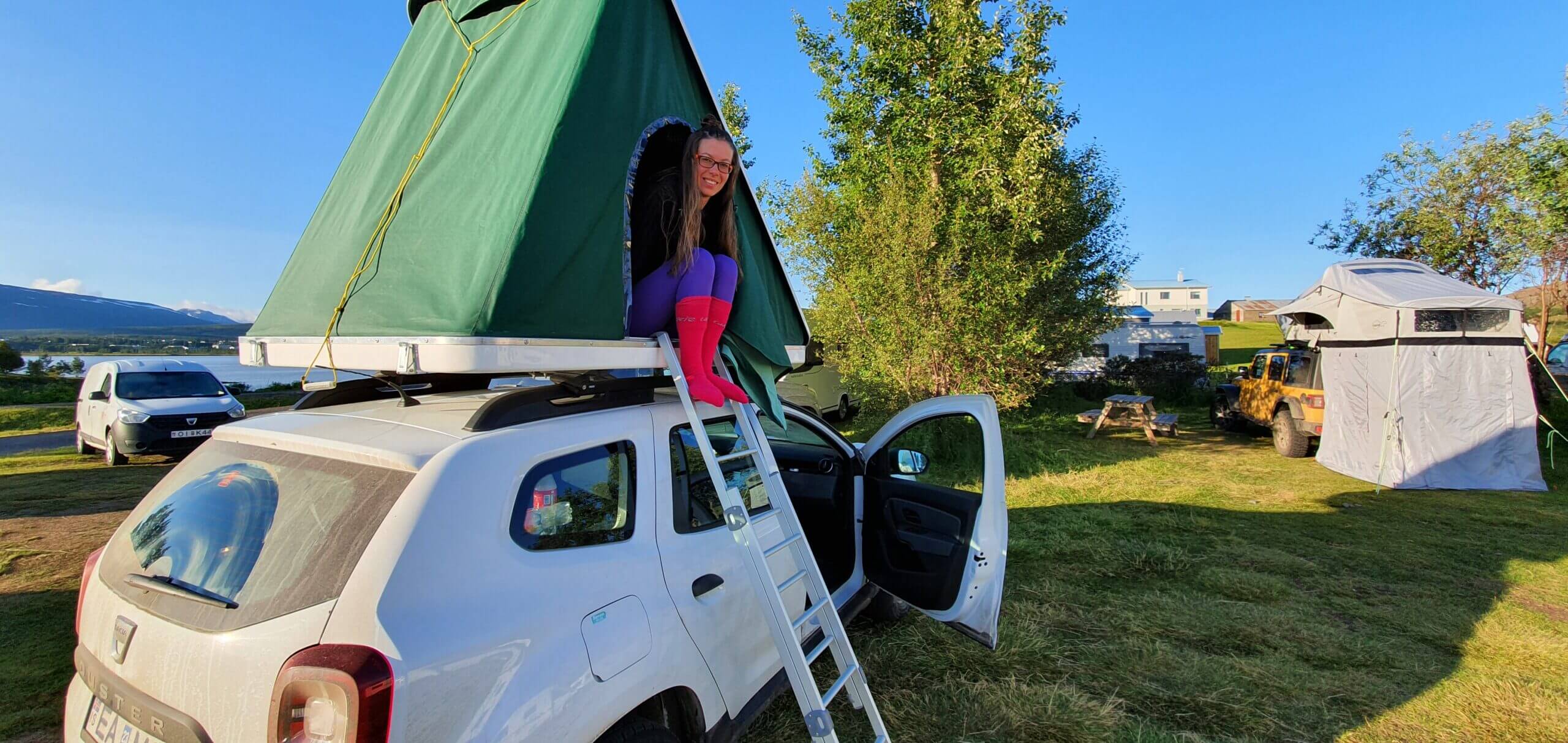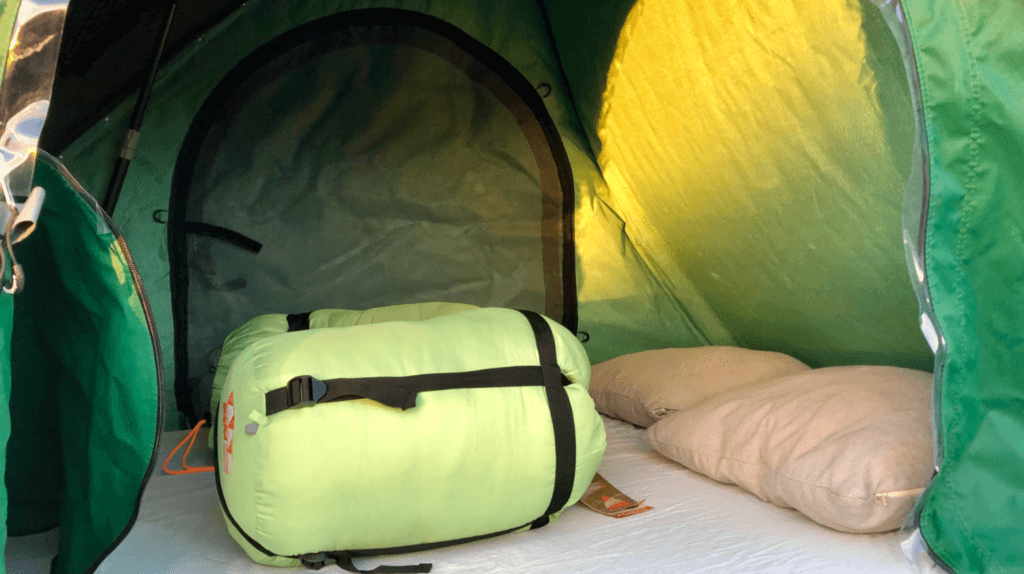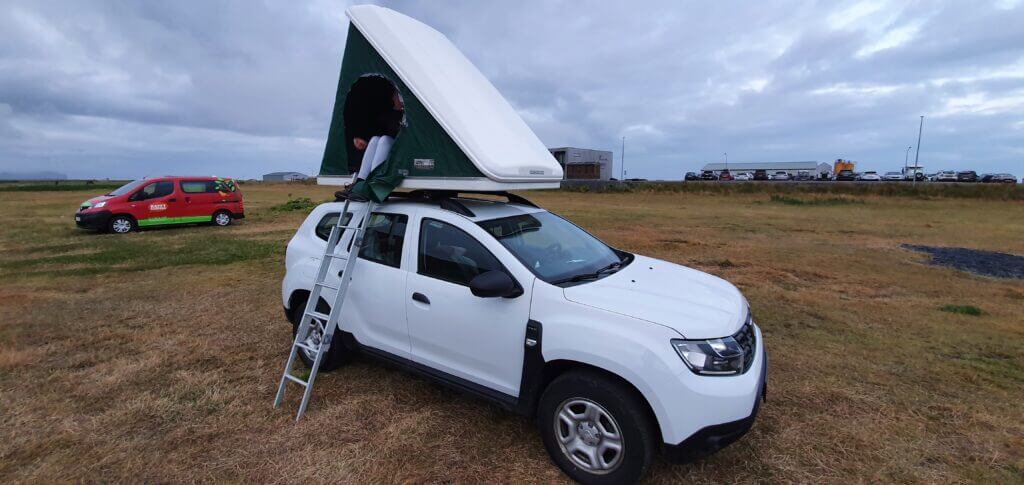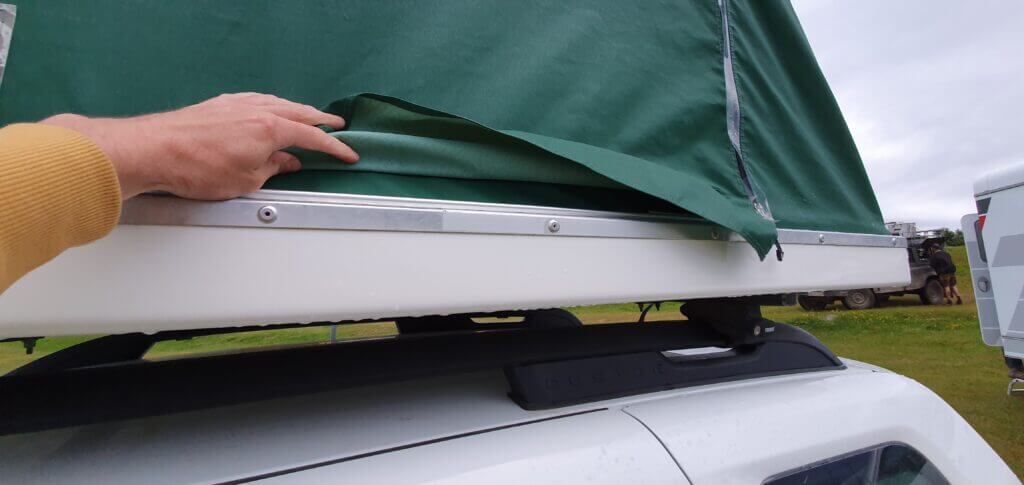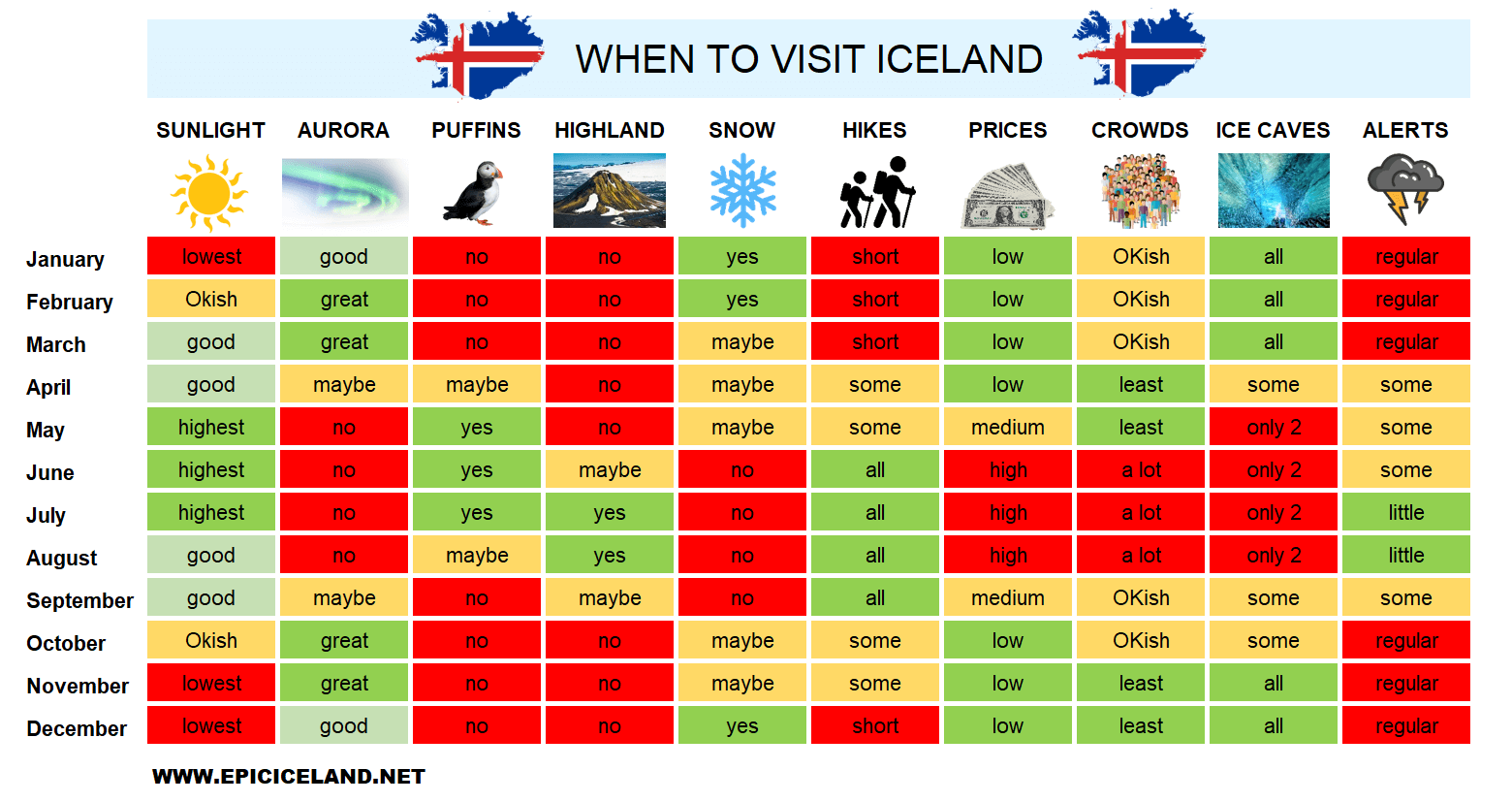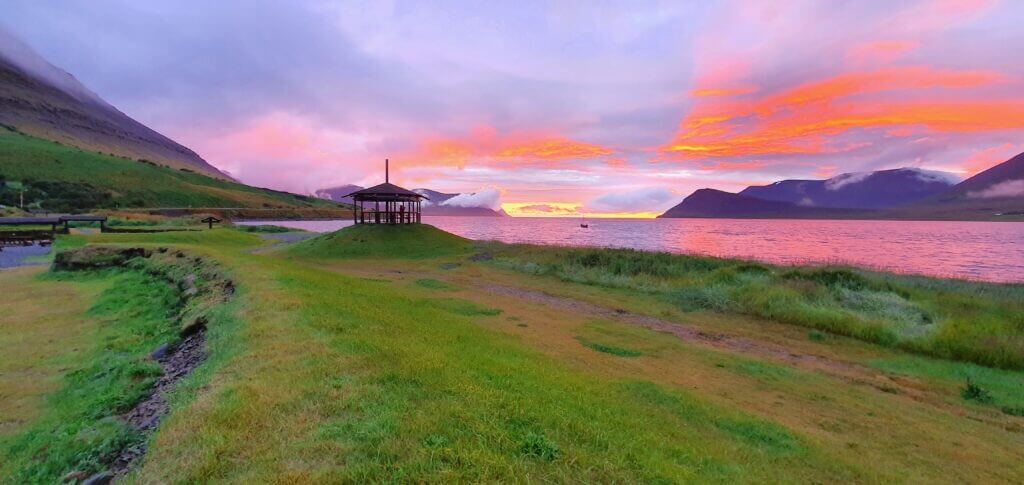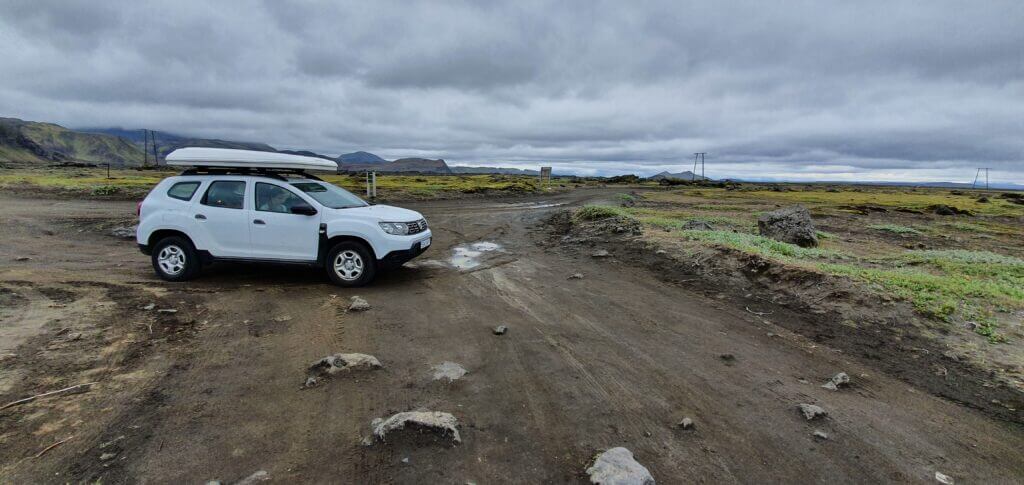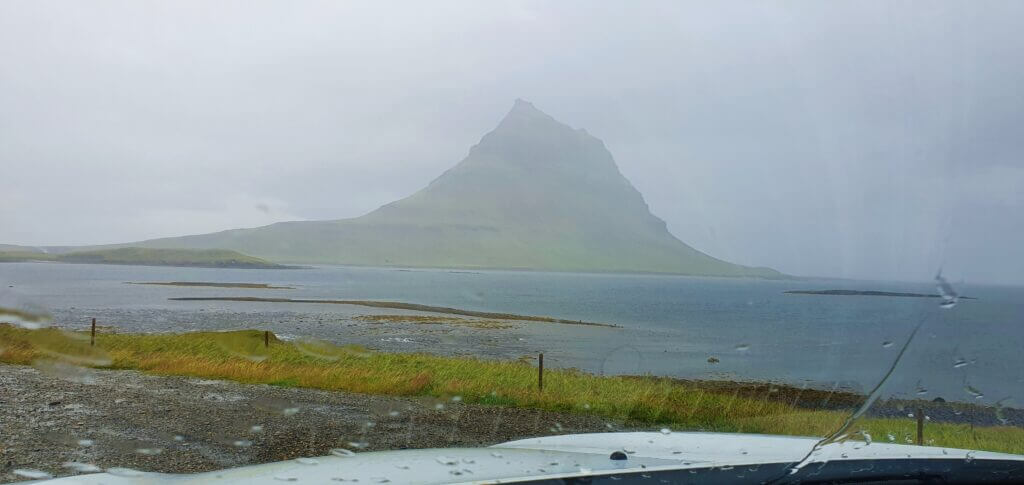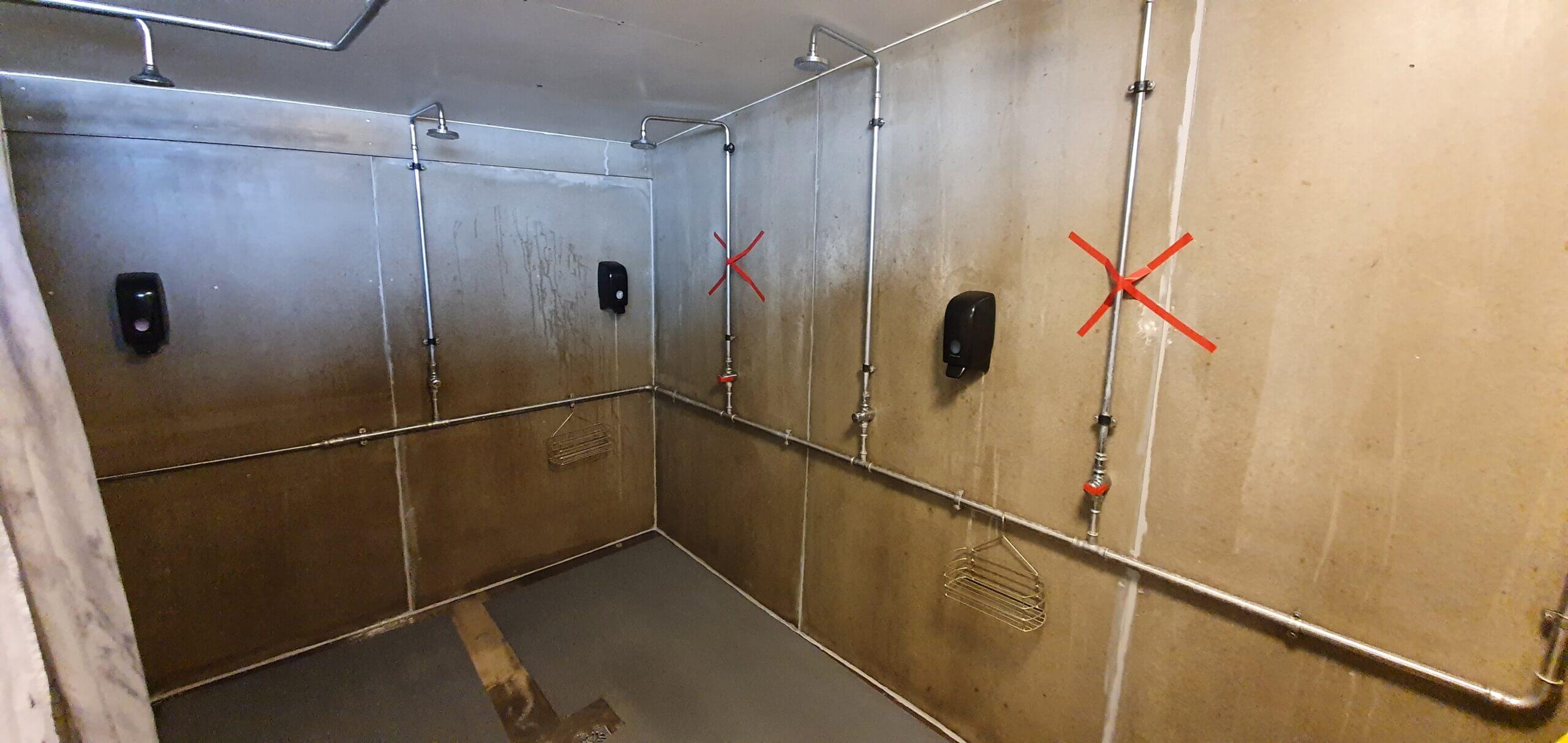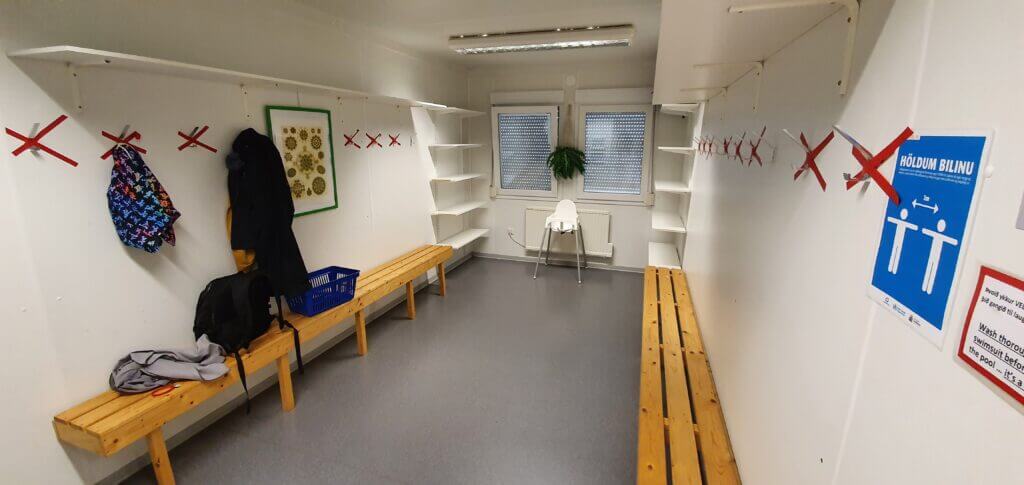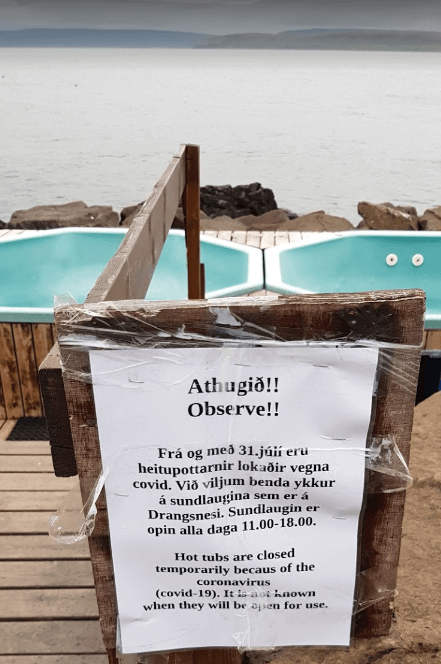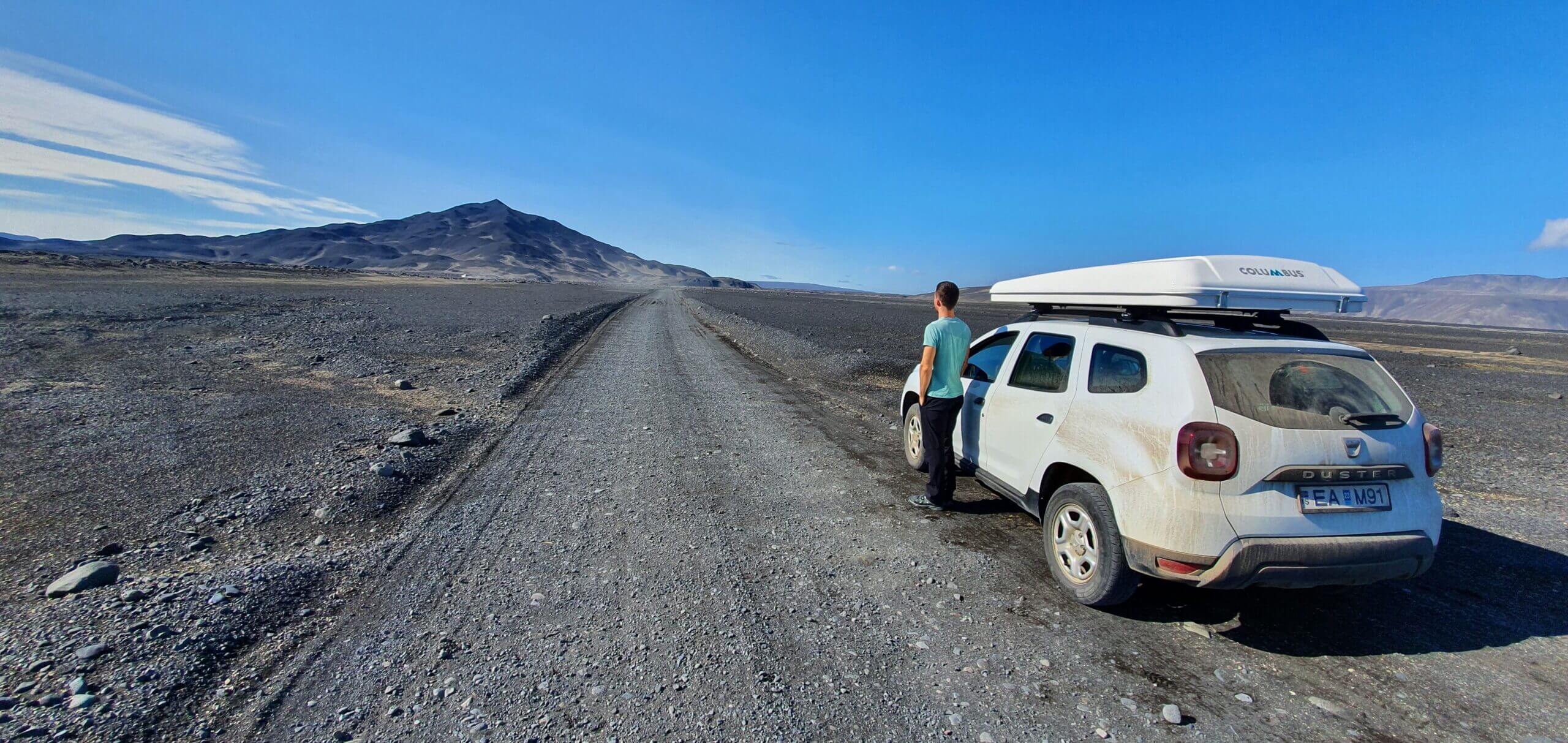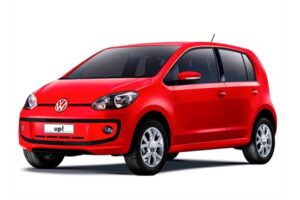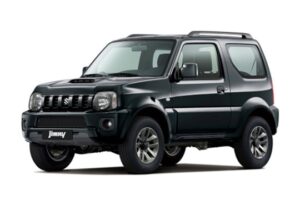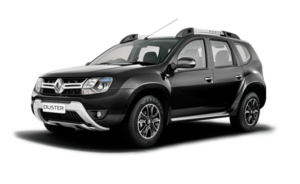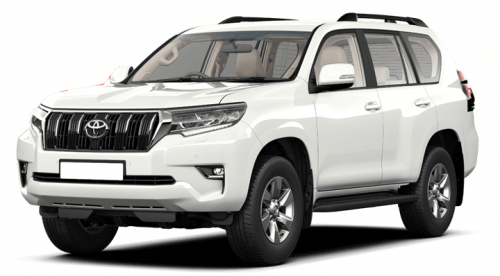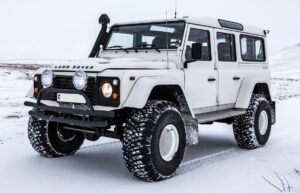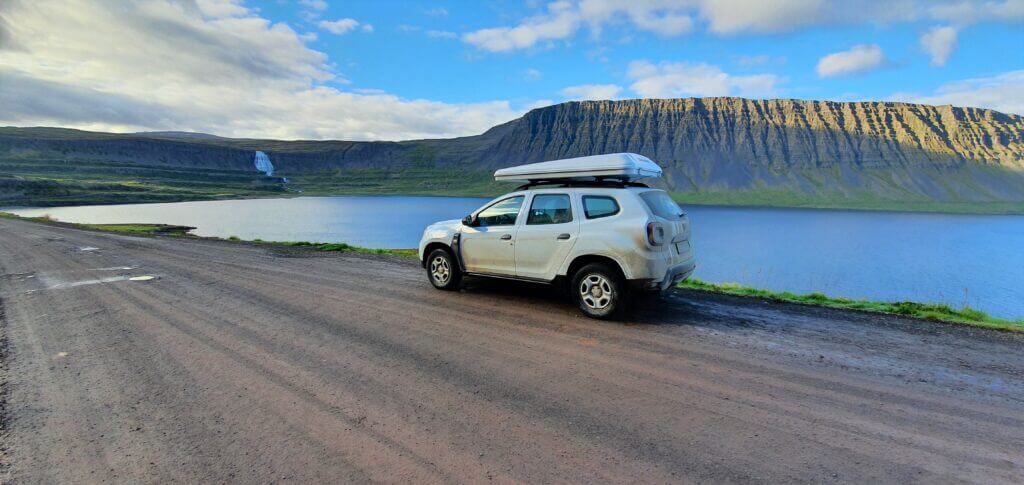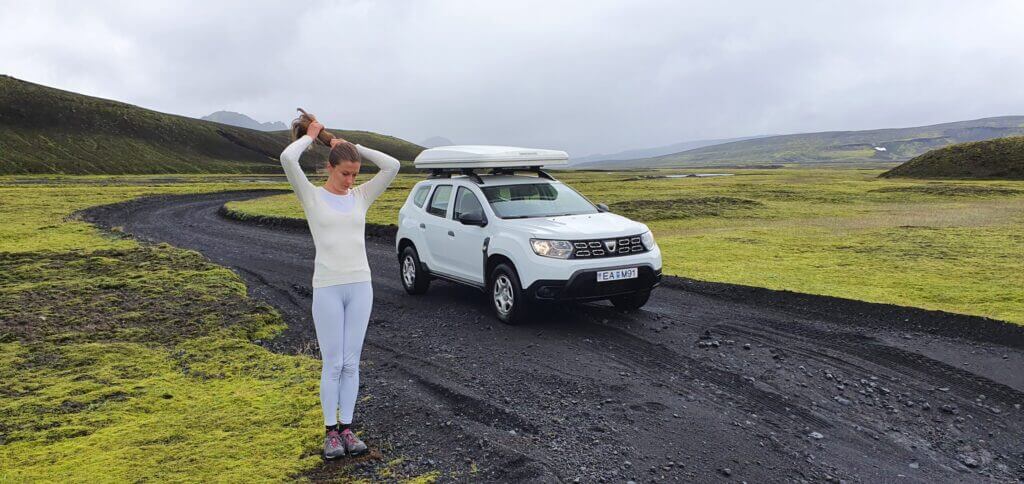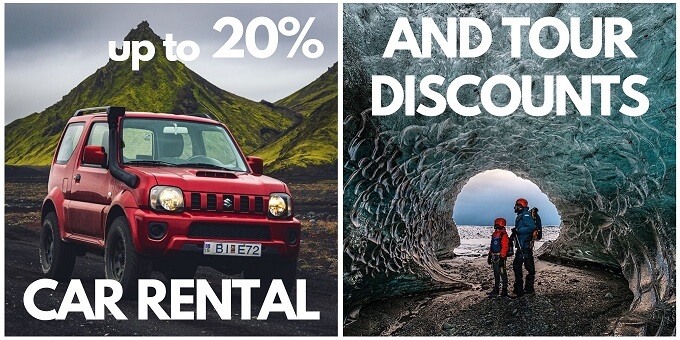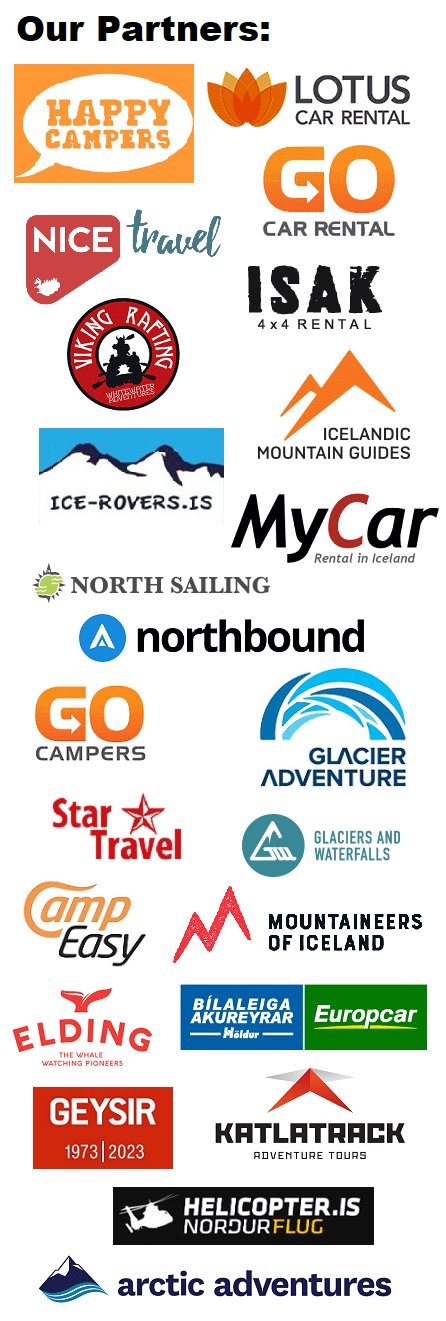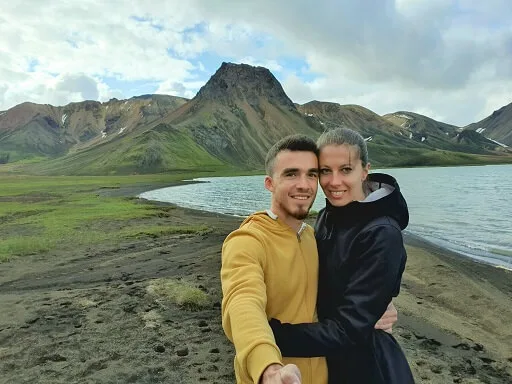We woke up on the foggy, cloudy morning in Kirkjubaerklaustur campsite. Exactly according to the forecast. By the way, weather forecasts were quite accurate during our stay. From Kirkjubaerklaustur it’s a short drive to one of the main sights we had been planning to see on day 5 of our journey – Fjaðrárgljúfur canyon.
Contents
Fjaðrárgljúfur canyon
9:50-10:20
Distance from car park: 5 minutes Time spent at: 15-30 minutes Worth visiting even with bad weather: yes Physical condition needed: little Interesting index: 1 – amazing (1-amazing, 2-great, 3-nice)
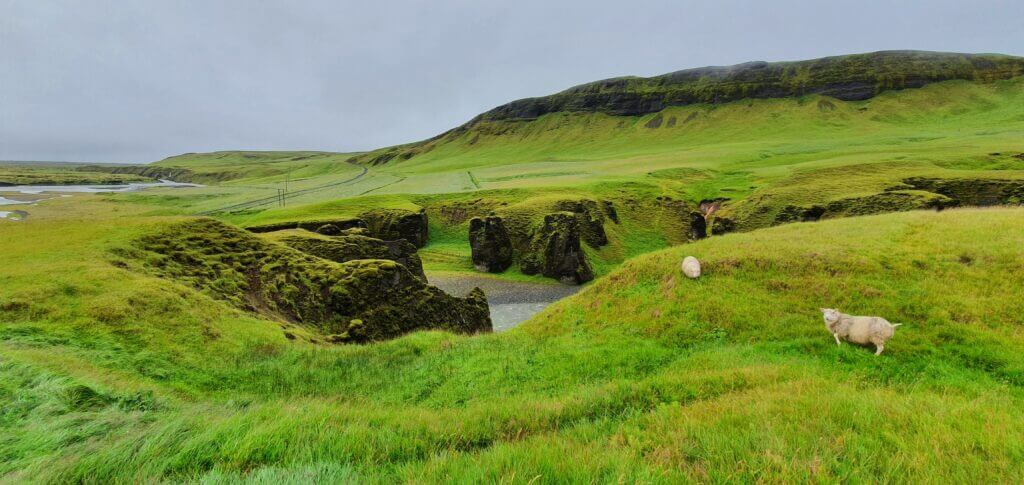
Picturesque surroundings of Fjaðrárgljúfur canyon
Compared to the day before – full of Landmannalaugar hiking – this was supposed to be much more relaxing day. Our first stop was, probably thanks to Mr Bieber, Fjaðrárgljúfur canyon. You’re going to spot the place quite clearly, because there will already be several cars parking at the spot before you arrive, regardless of time. Yes, Fjadrargljufur has become a really touristy place after Justin’s video even in Covid times.
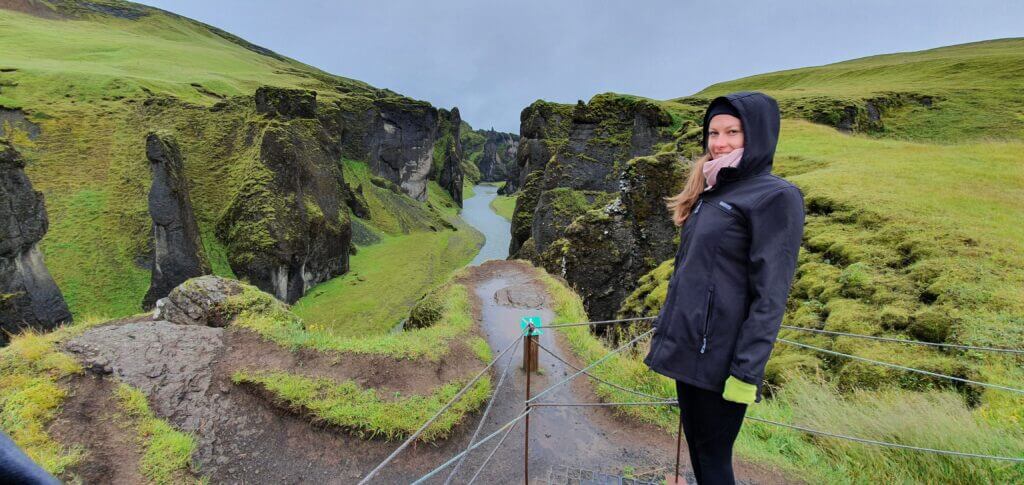
One of the main viewpoints at Fjaðrárgljúfur canyon
It will take you some 5 minutes from the parking lot to get to the canyon itself. Yes, Fjadrargljufur canyon is really nice, but compared to the Sigöldugljufur canyon, we were a bit disappointed after all that hype about it. This was definitely the most touristy canyon we’d visited, even during Covid times. Nevertheless, Fjadrargljufur canyon was still very nice and worth visiting.
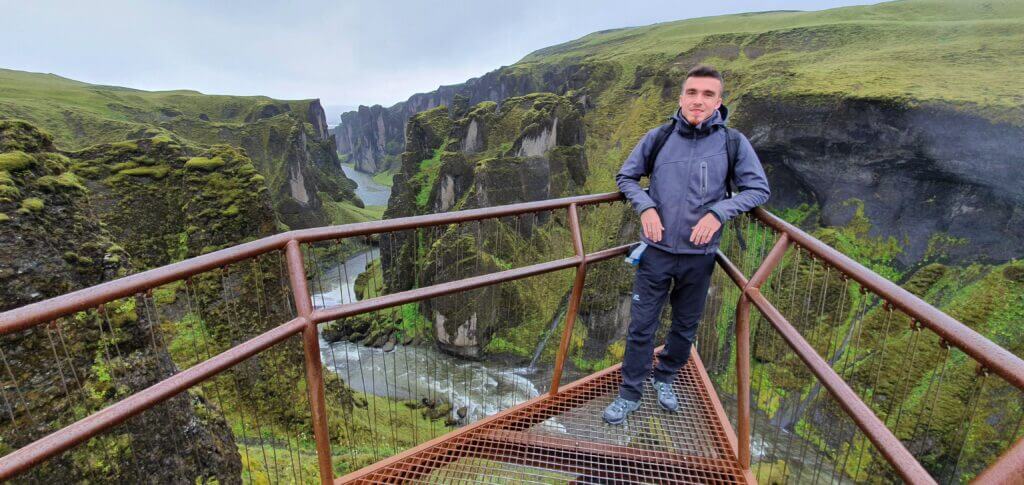
One of the main viewpoints at Fjaðrárgljúfur canyon
A few minutes before reaching Fjadrargljufur canyon there was a detour for Laki craters which we were considering going for. At the end of the day, we decided not to, due to mostly not very pleasant weather and tight schedule of ourselves (it was cloudy and it rained a little on the day of our visit with a half foggy air). There’s an F-road leading to Laki craters and in the event of nice weather, the views from Laki should be very nice. The entire trip takes a couple of hours and since the weather at the time of us passing by was quite foggy, we decided not to go.
Svartifoss in Skaftafell park
12:30-13:50
Distance from car park: 20-30 minutes one way Time spent at: 15-30 minutes Worth visiting even with bad weather: yes Physical condition needed: little Interesting index: 1 – amazing (1-amazing, 2-great, 3-nice)
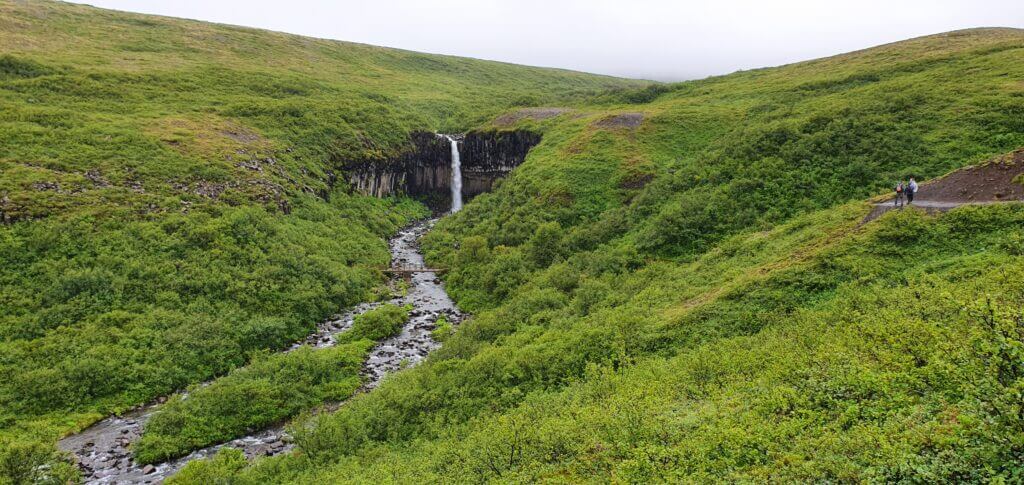
Svartifoss in the distance. 30 minutes before, all we could see was fog.
This was a touristy day and we were aware of it, as we were visiting the most touristy part of an Iceland – the south. Our next stop was Svartifoss waterfall famous mostly thanks to the Vikings series. Once we reached the car park of the Skaftafell national park, we realized what “touristy” actually means here. The car park and entire infrastructure around the entrance of the park were huge compared to all other sites we’d seen before. So we did park our car along 40 other cars and went for the Skaftafell trail towards Svartifoss.
Svartifoss trail takes some 20-30 minutes to complete, i.e. to reach the Svartifoss waterfall itself and it’s a fairly easy one. Map of the area is available e.g. here. You’re going to probably meet a lot of fellow tourists, as we did, along the path. When we reached the Svartifoss, however, there were just 2-3 couples together with us and shortly thereafter we were there all by ourselves. The weather was so-so with cloudy sky and slight fog. Still, Svartifoss was really beautiful and worth seeing.
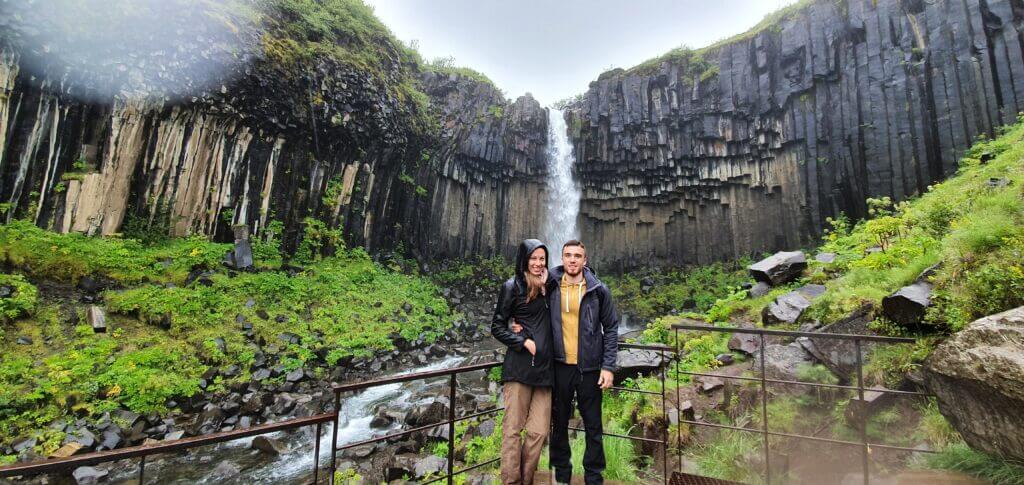
The closest viewpoint to Svartifoss after sky finally cleared a bit. Still, we are wet in the pic as you may see.
There are many other hiking trails in the Skaftafell national park, so if you are into hiking you have several options to go for. Since Svartifoss is supposed to be the highlight of the entire area, we again didn’t go for any other trail and went just for Svartifoss. After seeing it and enjoying the views we turned back towards our car.
It looked like we will be spending the night according to plan in Egilsstaðir so we decided to adhere to rules set by the Icelandic government and go for the second Covid testing as recommended. On our way back to the car park I called the health centre in Egilsstaðir with an inquiry whether we may come the next day for our second Covid test. I also explained that we prefer the earliest possible time to not interfere with our planned visit to Askja. A very friendly receptionist replied that yes, we may come the next day for testing even before the official start at 8 am and it shouldn’t take long to be tested. And, so we did.
Fjallsárlón and Jökulsárlón
15:00-16:00
Distance from car park: 5 minutes each Time spent at: 15-20 minutes each Worth visiting even with bad weather: yes Physical condition needed: little Interesting index: 3 – nice (1-amazing, 2-great, 3-nice)
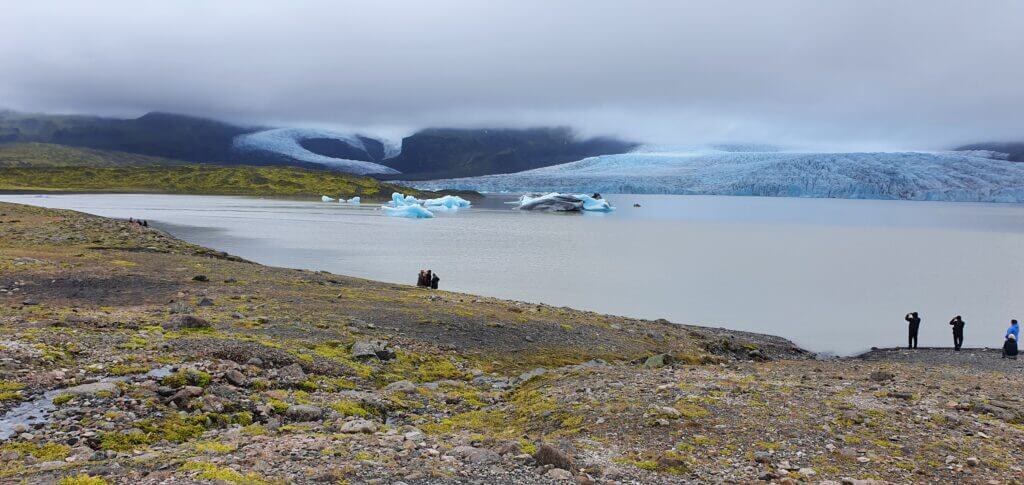
Fjallsárlón on a cloudy day
Fjallsárlón and Jökulsárlón are two glacial lakes located right next to the glacier. This means that you can observe pieces of glacier floating in the lake, which is an interesting experience. Coming from the Vik direction Fjallsárlón is the first and the smaller one compared to Jökulsárlón. That being said, Fjallsárlón experience is very similar to that of Jökulsárlón. And both are definitely touristy places, because of their easy accessibility by car and stable place in all Icelandic travel guides.
If we had to skip any sight due to lack of time, these two would probably be the ones we’d choose. It’s a short walk from the car park to the lake, where you can observe exactly what guides promise – pieces of glacier floating in the water. You may even approach the bank of the lake to look at these pieces from the closes possible point and even touch them if they are out on the shore.
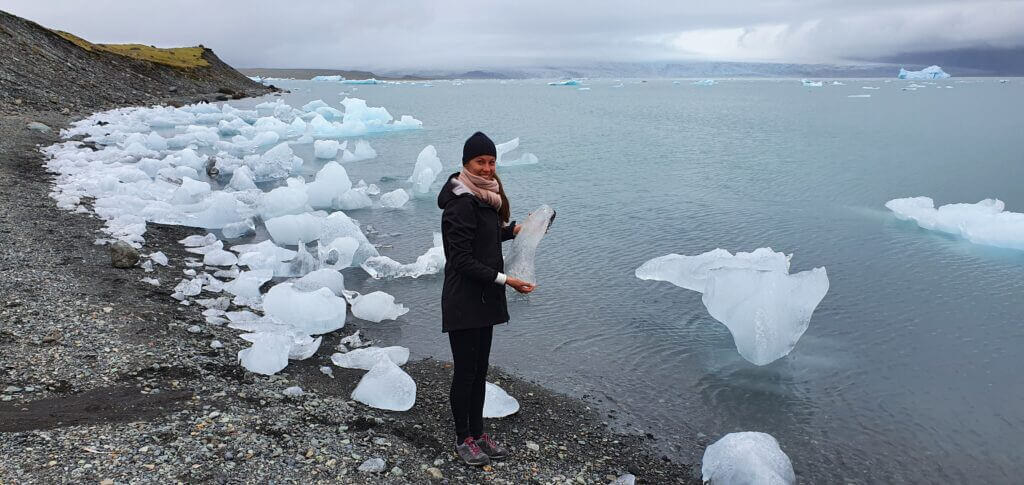
Making fancy iceberg pictures near Fjallsárlón
There are several guided boat trips around the lake, which will take you closer to the floating glaciers, or the big glacier itself. We didn’t find them to be worth the time (1-2 hours) and money (50-100eur/person) spent as the experience is quite similar to the one we already had and we aren’t any special fans of glaciers. As I already mentioned, and as you may read almost in every guide, Jökulsárlón is bigger and more touristy, but otherwise, the experience is about the same.
Höfn
17:30
Time spent at: 15-20 minutes Worth visiting even with bad weather: no Physical condition needed: little Interesting index: 3 – nice (1-amazing, 2-great, 3-nice)
Our ultimate destination where we wanted to camp on day 5 of our Icelandic journey was supposed to be eastern metropole of Egilsstaðir. This was also the place where we were supposed to take the second Covid test the next day in the morning. On our way towards Egilsstaðir, we wanted to firstly stop at Höfn. According to guides and Google maps, this was supposed to be a nice small village by the sea with beautiful views of the surrounding volcanic mountains. That sounds like a nice place to make a short stop.
The reality was, however, slightly different, as the weather on that day kept being cloudy and foggy. Hence, once we arrived at Höfn, there was no visibility of the surrounding mountains and we were able to see only the small part of them. Apart from the mountains, we realized there was nothing particularly fascinating about Höfn, so, after a short meal break, we continued our road towards Egilsstaðir.
Eastfjords and Öxi road
18:30-20:45
Worth visiting even with bad weather: yes, probably Interesting index: 1 – amazing (1-amazing, 2-great, 3-nice)
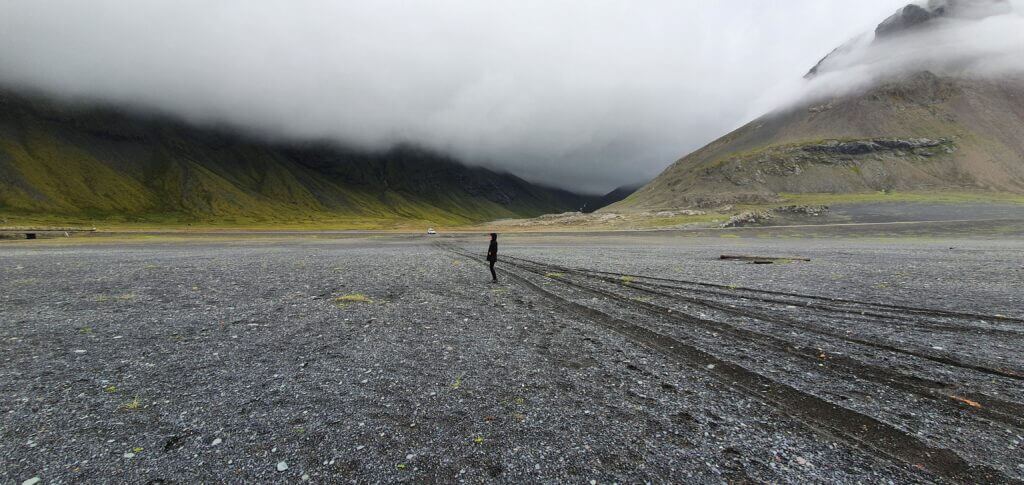
Short stop near Djúpivogur. Observe illegal off-road driving by someone.
If we wanted to see the best of Iceland in 12 days, we didn’t have enough time to explore Eastfjords separately, that’s why we just drove through them. When we left Höfn, we headed towards Djúpivogur, enjoying a nice part of southeast fjords. The weather was still only so-so with frequent clouds and quick rain showers alternating with brief periods of sunbeams penetrating the clouds. The seaside drive was very nice, although I can imagine, it may be even better in case of completely clear weather.
We’d driven already for more than 1,5 hour when we reached the junction with the road 939, with Google maps saying that exactly the road 939 should be the quickest way towards Egilsstaðir. We turned to 939, or the so-called “Öxi road” accordingly, not knowing at that time why the road has a name. Many other roads in Iceland don’t have any name. Well, we shortly found out why. Öxi road looked like a former F-road, or at least something very similar to the F-road. It was a gravel road with a lot of potholes and right after turning to it, it started to be quite steep.
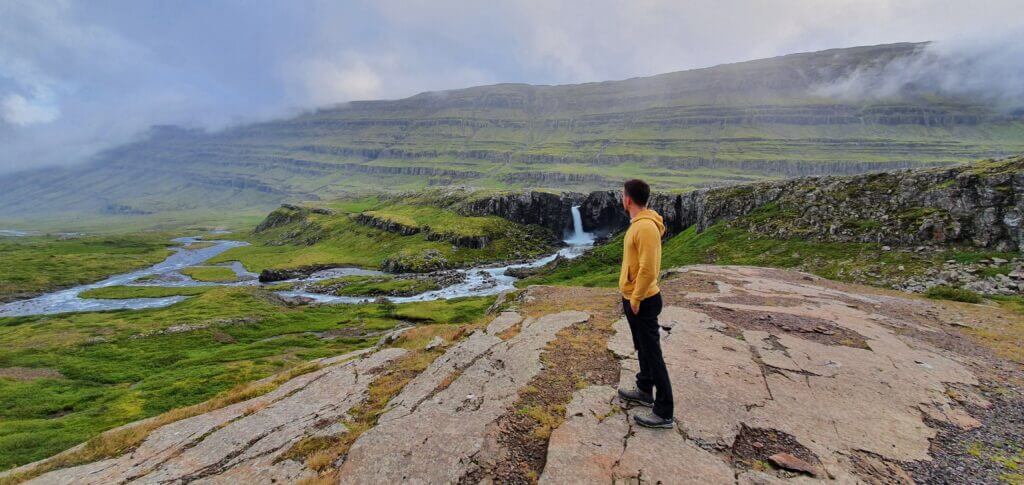
Icelandic crazy Öxi road 939 – one of the viewpoints in the beginning
We’d experienced a short interlude of some nice weather when beginning with the Öxi drive and soon after driving on Öxi we reached a small car park where we saw several people taking pictures. This spot (see above) wasn’t marked on the Google maps, nor had I read anything about it. Nevertheless, we parked our car, got out of it and realized why do so many people take pictures. An amazingly picturesque valley full of waterfalls, fairytale-like green moss and cliffs emerged in front of us. Out of this world experience once again. One of the most beautiful photo spots of our entire trip. It was probably possible even to come closer to the waterfall valley by walking, but we remained satisfied with the look we just saw and continued through Öxi further.
This was the time when we finally realized why this road has a name. Öxi was a quite steep mountain road with lots of turns, potholes and beautiful scenery alongside it. I’d never read about it beforehand, but whatever, that’s Iceland, right? Our weather wasn’t ideal at all, with fog getting heavier and rain starting to pour persistently. Hence, the entire Öxi experience had become quite scary at some point, with my girlfriend starting to have a facial expression as if she were in a horror movie. The entire drive took some fair 45 minutes in these weather conditions. Once we turned to road 95, we also popped out of the fog and the weather was nice once again, keeping the fog and the rain at the Öxi road.
Egilsstaðir and Fellabaer camping
21:30-
Soon, we reached Egilsstaðir around 9 pm, where we had planned to camp. That’s what we’d planned. However, having arrived at the campsite, the receptionist told us their campsite is full and they cannot take even more cars, now that the new Covid distancing restrictions are in place. So, for the first time, we were denied camping and we felt really desperate at that moment. We were really tired after an entire day and didn’t really feel like searching for another camp. The receptionist, however, was so nice to check for us, whether the nearest camp in Fellabaer has free space.
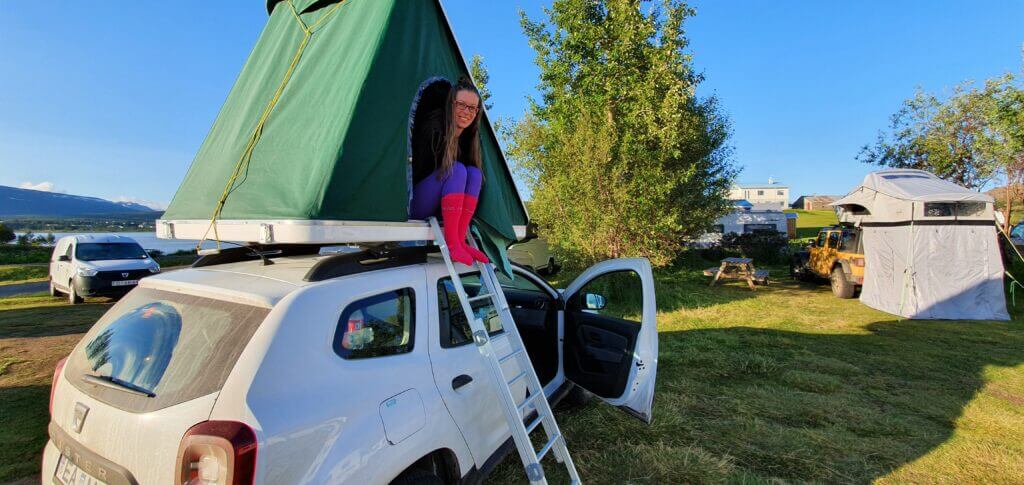
Fellabær campsite next to Egilsstaðir
After her call, she got a positive reply and so we headed another 5-7 minutes towards Fellabaer where we camped at the small local campsite. This camp probably mostly served as a substitute in cases like this, when Egilsstaðir campsite happens to be full. The campsite was alright, although a bit small and not very modern, but it had everything we needed. Moreover, the kitchen was empty at the time when we wanted to cook the dinner, despite being really small.
Skipped places
- Laki craters (foggy weather)
- different trails in Skaftafell, especially Skaftafellsjökull viewpoint due to foggy and rainy weather
- Svínafellsjökull
- Hoffel hot tubs (paid and no time)
We skipped Laki craters due to bad visibility (cloudy and foggy weather) and prioritization of other sights which were about to follow on our journey. It’s also possible to hike several different trails in Skaftafell park, which we didn’t because the one towards Svartifoss was supposed to be the most beautiful.
If we went to Iceland next time and the weather was good, we would definitely go to Skaftafellsjökull viewpoint – a view over a magnificent glacier, which looked really nice in the pictures. It’s also possible to go see Svínafellsjökull for similar views and should be also worth visiting. The last sight we skipped were Hoffel hot tubs, due to the lack of time and a detour we didn’t find worth spending time on during our packed trip schedule.

